

Self-Introduction Essay
Self introduction essay generator.
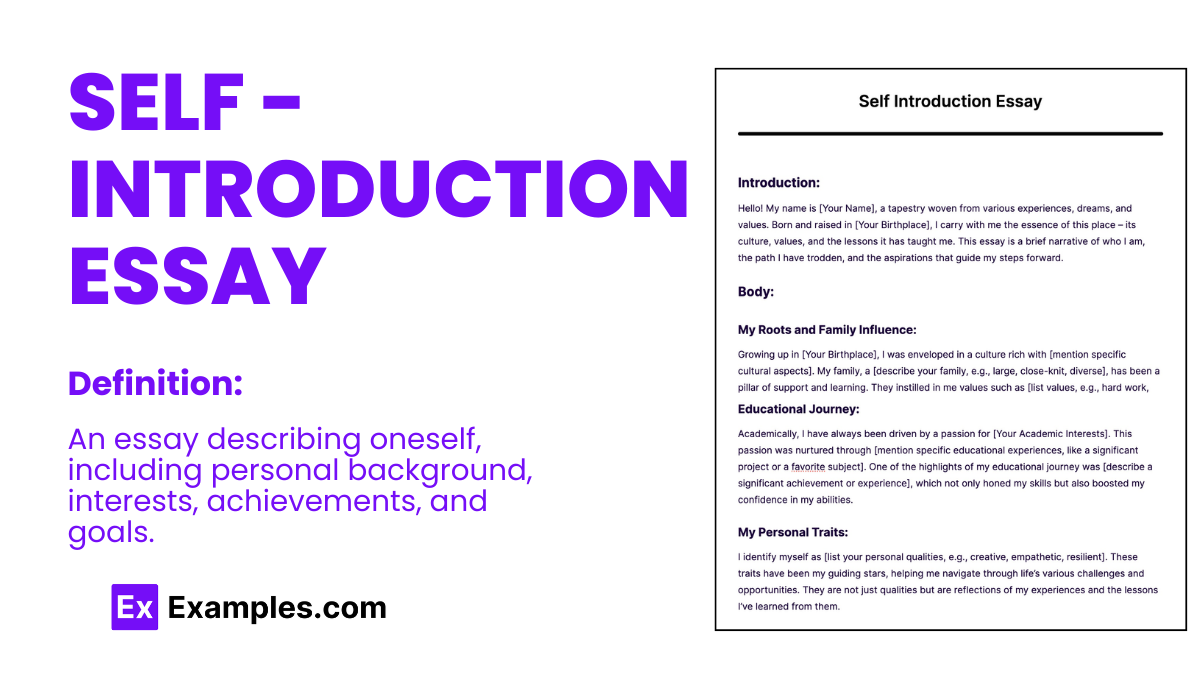
A Self Introduction Essay is a window into your personality, goals, and experiences. Our guide, supplemented with varied essay examples , offers insights into crafting a compelling narrative about yourself. Ideal for college applications, job interviews, or personal reflections, these examples demonstrate how to weave your personal story into an engaging essay. Learn to highlight your strengths, aspirations, and journey in a manner that captivates your readers, making your introduction not just informative but also memorable.
What is Self Introduction Essay? A self-introduction essay is a written piece where you describe yourself in a personal and detailed way. It’s a way to introduce who you are, including your name, background, interests, achievements, and goals. This type of essay is often used for college or job applications, allowing others to get to know you better. It’s an opportunity to showcase your personality, experiences, and what makes you unique. Writing a self-introduction essay involves talking about your educational background, professional experiences if any, personal interests, and future aspirations. It’s a chance to highlight your strengths, achievements, and to share your personal story in a way that is engaging and meaningful.
Do you still remember the first time you’ve written an essay ? I bet you don’t even know it’s called an “essay” back then. And back then you might be wondering what’s the purpose such composition, and why are you writing something instead of hanging out with your friends.
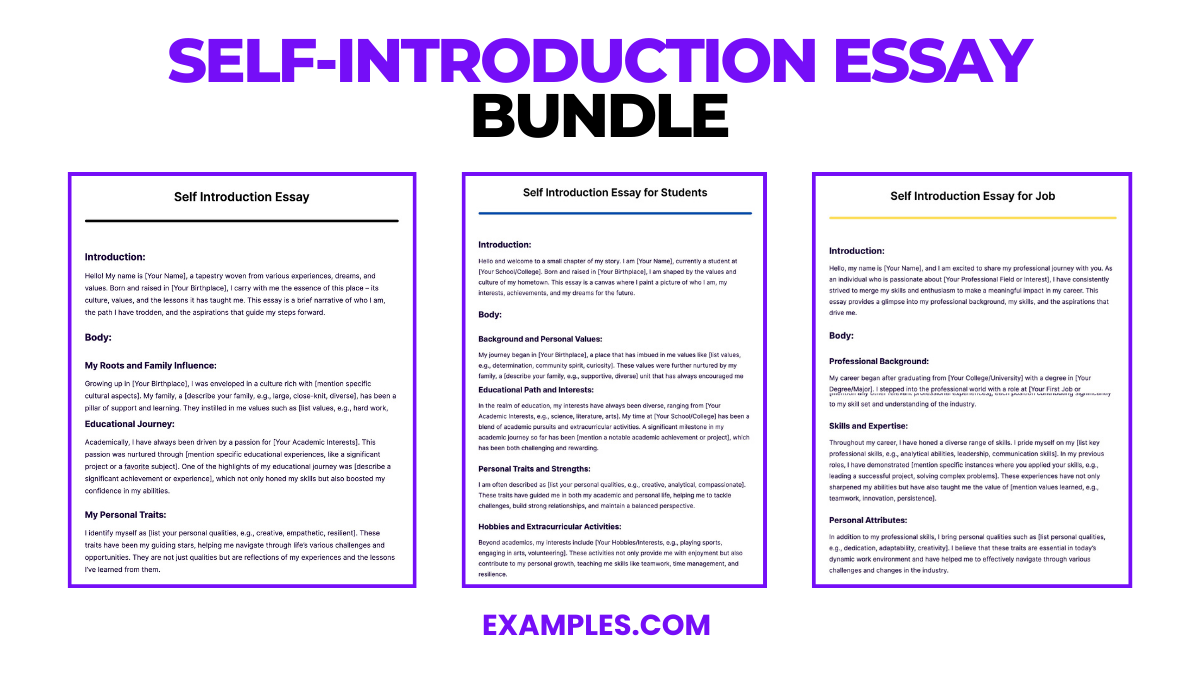
Download Self-Introduction Essay Bundle
Now, you probably are already familiar with the definition of an essay, and the basics of writing one. You’re also probably aware of the purpose of writing essays and the different writing styles one may use in writing a composition. Here, we will be talking about self-introduction essay, and look into different example such as personal essay which you may refer to.
Self Introduction Essay Format
Introduction.
Start with a hook: Begin with an interesting fact, a question, or a compelling statement about yourself to grab the reader’s attention. State your name and a brief background: Share your name, age, and where you’re from or what you currently do (student, job role).
Educational Background
Discuss your current or most recent educational experience: Mention your school, college, or university and your major or area of study. Highlight academic achievements or interests: Share any honors, awards, or special projects that are relevant to your personality or career goals.
Professional Background
Mention your current job or professional experiences: Briefly describe your role, company, or the type of work you do. Highlight relevant skills or achievements: Share experiences that showcase your abilities and contributions to your field.
Personal Interests and Goals
Share your hobbies or interests: Briefly describe activities you enjoy or passions you pursue outside of work or school. Discuss your short-term and long-term goals: Explain what you aim to achieve in the near future and your aspirations for the long term.
Summarize your strengths and what makes you unique: Reinforce key points about your skills, achievements, or character. Close with a statement on what you hope to achieve or contribute in your next role, educational pursuit, or personal endeavor.
Example of Self Introduction Essay in English
Hello! My name is Alex Johnson, a 21-year-old Environmental Science major at Green Valley University, passionate about sustainable living and conservation efforts. Raised in the bustling city of New York, I’ve always been fascinated by the contrast between urban life and the natural world, driving me to explore how cities can become more sustainable. Currently, in my final year at Green Valley University, I’ve dedicated my academic career to understanding the complexities of environmental science. My coursework has included in-depth studies on renewable energy sources, water conservation techniques, and sustainable agriculture. I’ve achieved Dean’s List status for three consecutive years and led a successful campus-wide recycling initiative that reduced waste by 30%. This past summer, I interned with the City Planning Department of New York, focusing on green spaces in urban areas. I worked on a project that aimed to increase the city’s green coverage by 10% over the next five years. This hands-on experience taught me the importance of practical solutions in environmental conservation and sparked my interest in urban sustainability. Beyond academics, I’m an avid hiker and nature photographer, believing strongly in the power of visual storytelling to raise awareness about environmental issues. My goal is to merge my passion for environmental science with my love for photography to create impactful narratives that promote conservation. In the future, I aspire to work for an NGO that focuses on urban sustainability, contributing to projects that integrate green spaces into city planning. I am also considering further studies in environmental policy, hoping to influence positive change on a global scale. My journey from a curious city dweller to an aspiring environmental scientist has been driven by a deep passion for understanding and protecting our natural world. With a solid educational foundation and practical experience, I am eager to contribute to meaningful environmental conservation efforts. I believe that by combining scientific knowledge with creative communication, we can inspire a more sustainable future for urban areas around the globe.
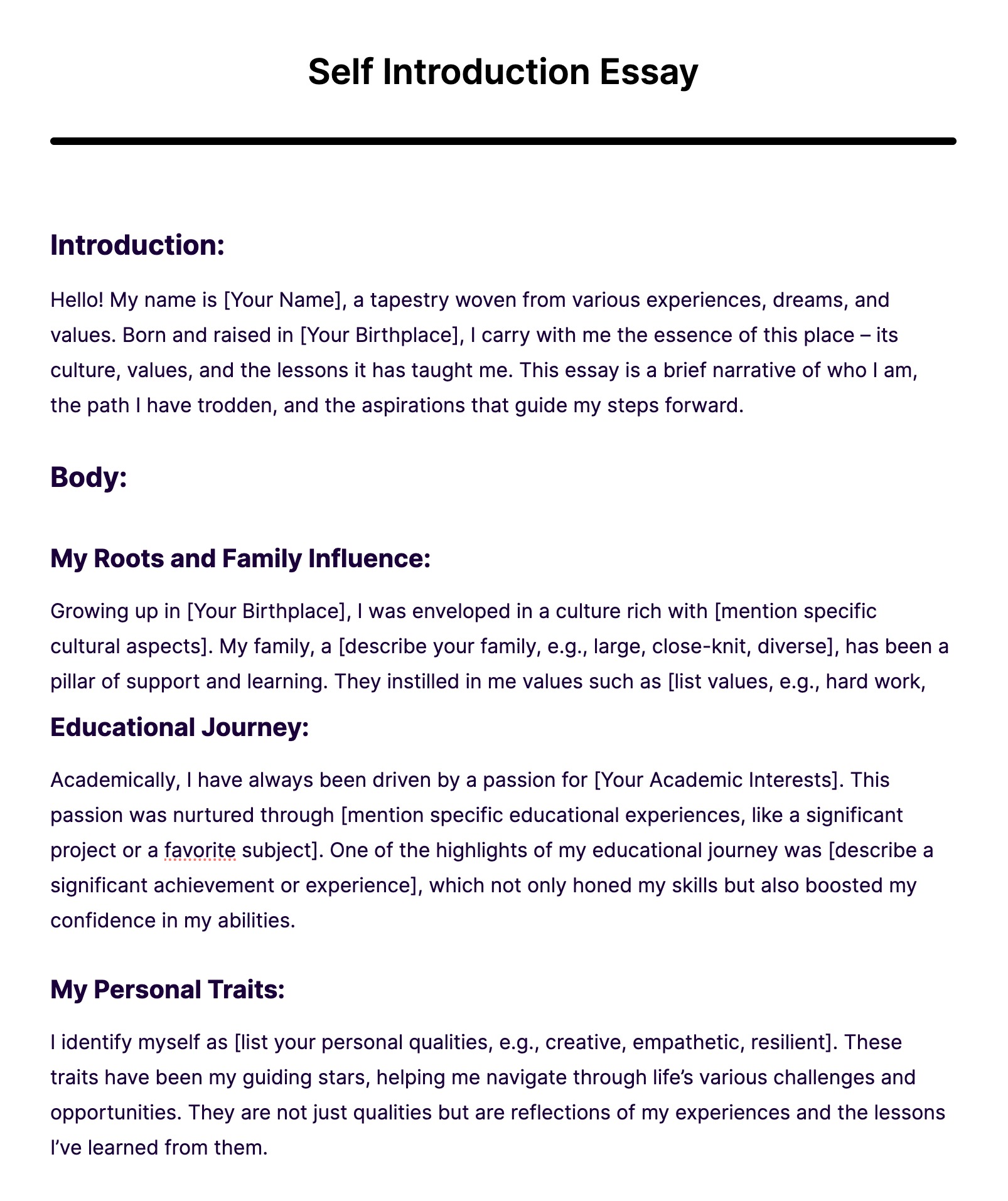
Self Introduction Essay for Job

Self Introduction Essay for Students
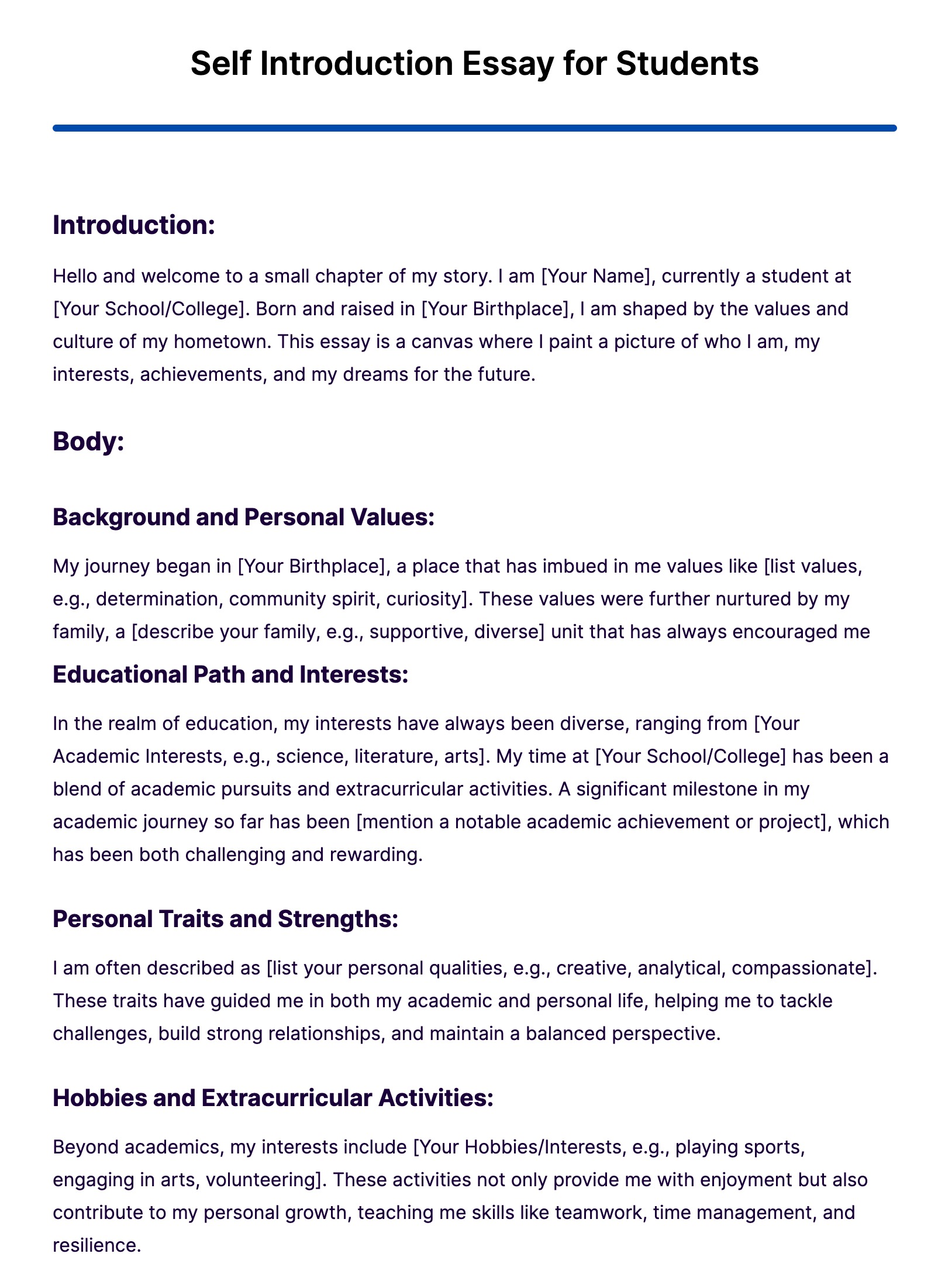
Self Introduction Essay Example

Size: 119 KB
Self Introduction For College Students Example

Size: MS Word
Simple Self Introduction For Job Example

Size: 88.4 KB
Free Self Introduction For Kids Example
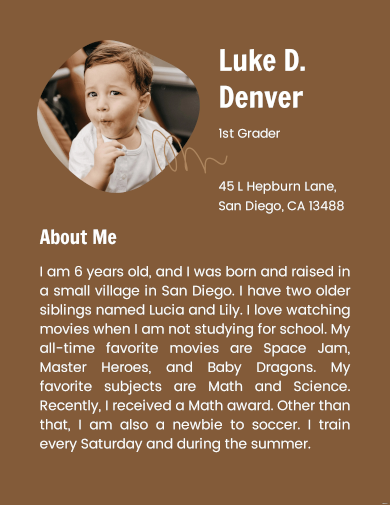
Size: 123 KB
Simple Self Introduction Example
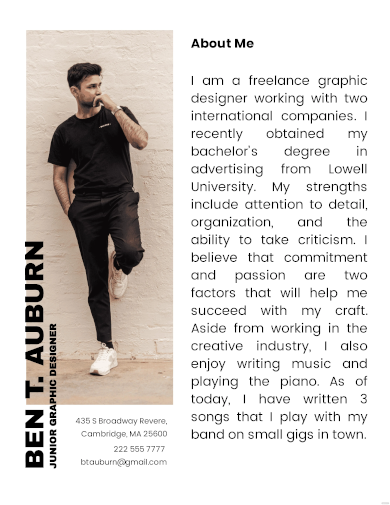
Size: 178 KB
Self Introduction For Freshers Example

Size: 96.2 KB
Free Self Introduction For Interview Example
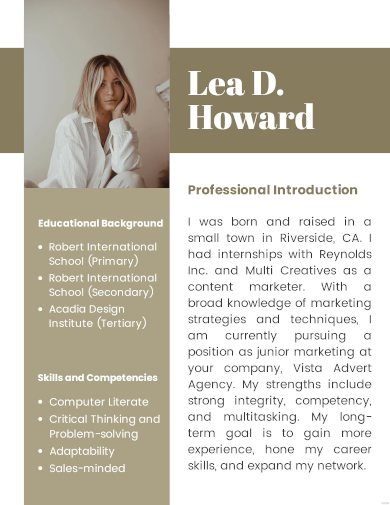
Size: 129 KB
Company Self Introduction Example
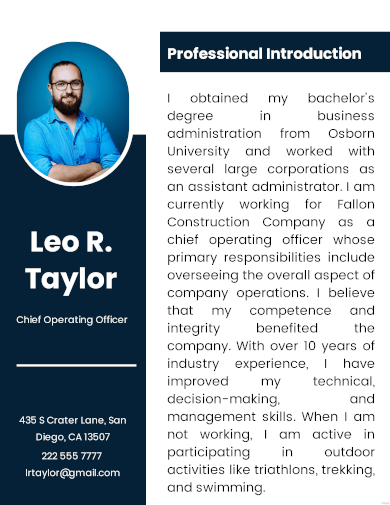
Size: 125 KB
Self Introduction For First Day At Work Sample

Size: 124 KB
Sample Self Introduction for Scholarship Example
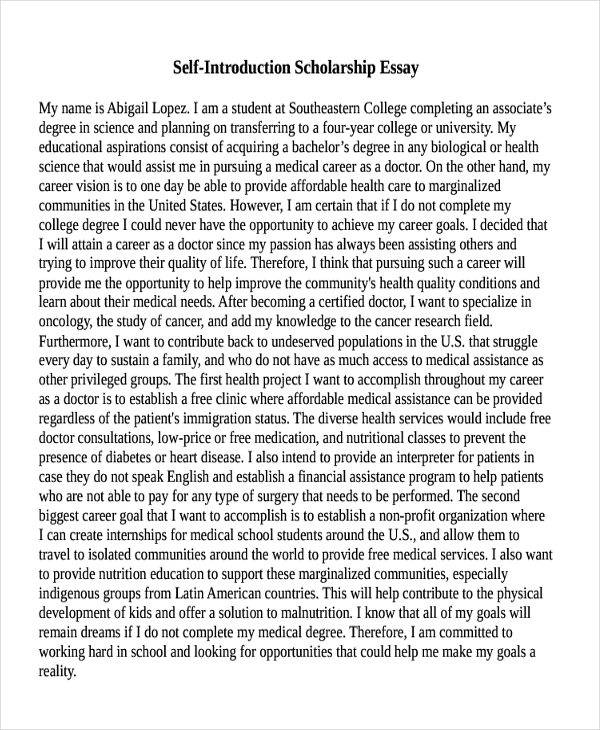
scholarshipsaz.org
Size: 33 KB
Free Self Introduction Sample Example
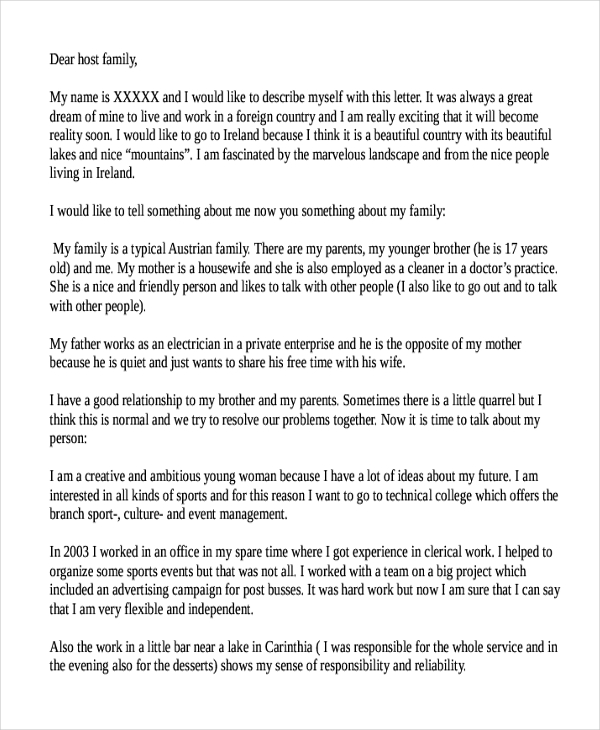
au-pair4you.at
Size: 22 KB
Creative Essay for Internship Example
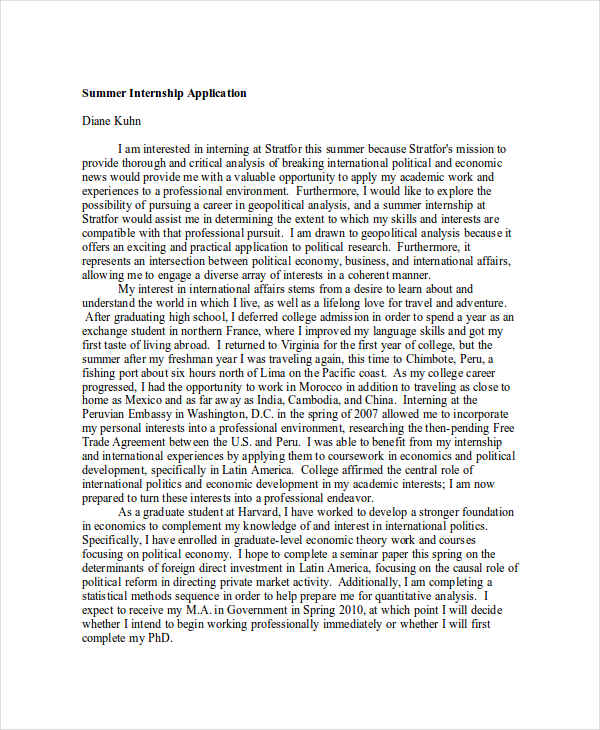
wikileaks.org
What to Write in a Self-Introduction Essay
A self-introduction essay, as the name suggest, is an part of an essay containing the basic information about the writer.
In writing a self-introduction essay, the writer intends to introduce himself/herself by sharing a few personal information including the basics (e.g. name, age, hometown, etc.), his/her background information (e.g. family background, educational background, etc.), and interesting facts about him/her (e.g. hobbies, interests, etc). A self-introductory essay primarily aims to inform the readers about a few things regarding the writer. You may also see personal essay examples & samples
How to Write a Self-Introduction Essay
A self-introduction essay is, in most cases, written using the first-person point of view. As a writer, you simply need to talk about yourself and nothing more to a specific audience. You may also like essay writing examples
A self-introduction essay can be easy to write, since all you have to do is to introduce yourself. However, one needs to avoid sounding like a robot or a person speaking in monotone. Of course, you need to make the composition interesting and engaging, instead of making it plain and bland. This is probably the main challenge of writing a self-introduction essay, and the first thing every writer needs to be aware of.
Free Essay Outline Worksheet Example

englishwithhallum.com
Size: 40 KB
Free Interesting Self Introduction for Student Example
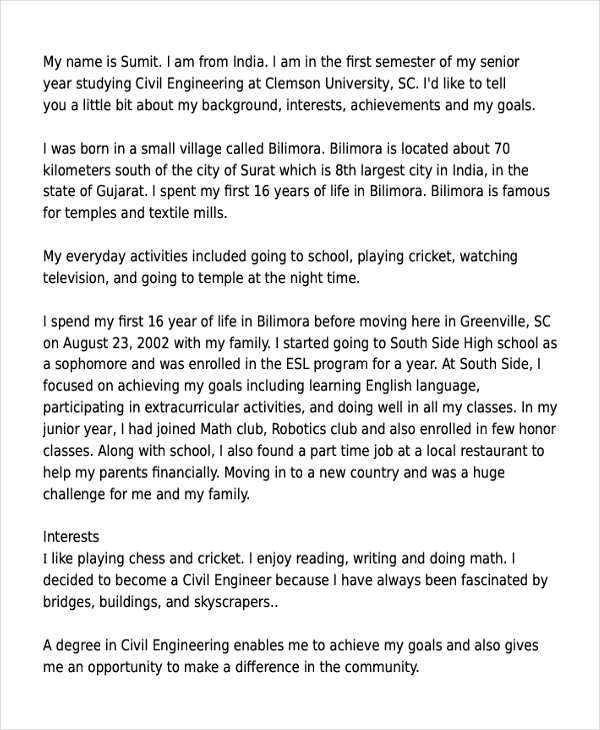
essayforum.com
Size: 14 KB
Free Attractive Introduction Essay for Interview Example
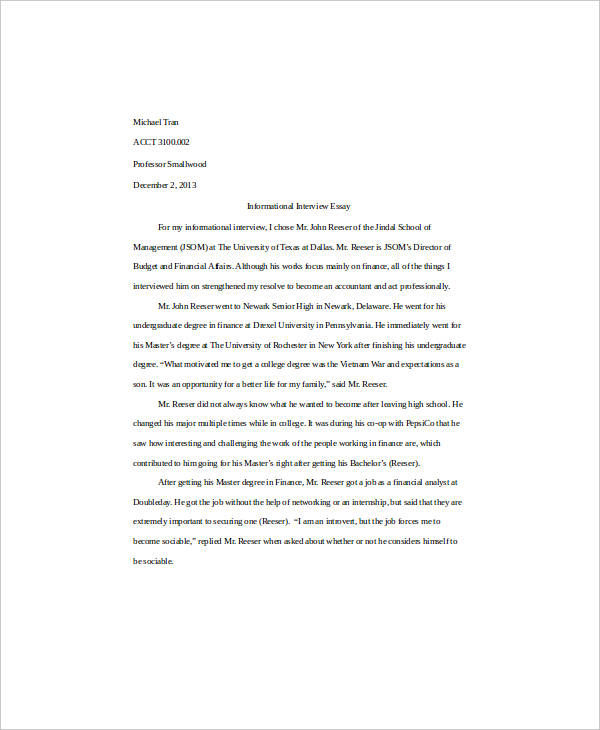
michaeltran27.weebly.com
Size: 17 KB
Formal Self Introduction Expository Example
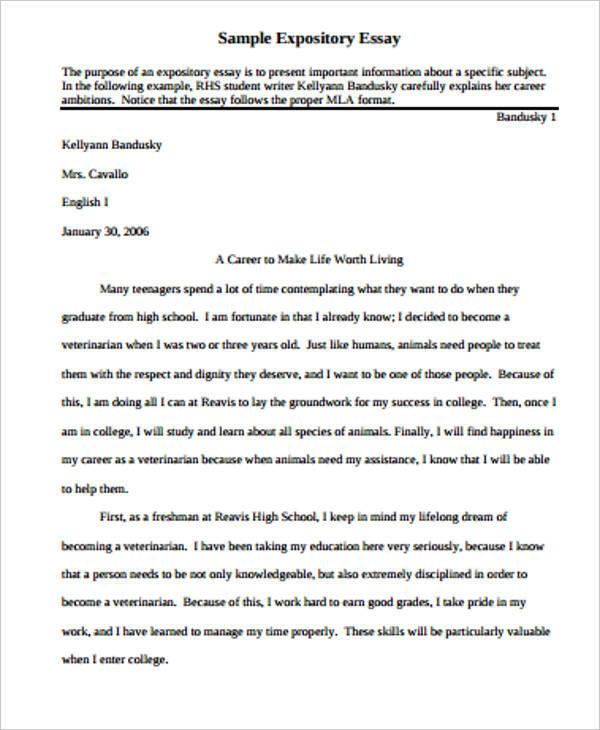
teacherweb.com
Uses of Self Introduction Essay
- College Applications : Many universities and colleges ask for a self-introduction essay as part of the application process. This essay allows admissions officers to learn more about your personality, background, and aspirations beyond your grades and test scores.
- Scholarship Applications : When applying for scholarships, a self-introduction essay can help you stand out. It’s an opportunity to share your achievements, experiences, and the reasons you deserve the scholarship.
- Job Interviews : Preparing a self-introduction essay can be useful for job interviews. It helps you articulate your professional background, skills, and career goals clearly and confidently.
- Networking : In professional networking situations, having a polished self-introduction essay can help you quickly share relevant information about yourself with potential employers, mentors, or colleagues.
- Personal Reflection : Writing a self-introduction essay is a valuable exercise in self-reflection. It can help you understand your own goals, strengths, and weaknesses better.
- Online Profiles : For personal or professional websites, social media, or portfolios, a self-introduction essay provides a comprehensive overview of who you are and what you offer, attracting potential connections or opportunities.
Tips for Writing a Self-Introduction Essay
A self-introduction essay might be one of the easiest essays to start. However, one needs to learn a few things to make the composition worth reading. You might find a lot of tips online on how to write a self-introduction essay, but here are some tips which you might find useful.
1. Think of a catchy title
The first thing that attracts readers is an interesting title, so create one.
2. Introduce yourself
You can create some guide questions to answer like: Who are you? What are your interests? What is your story? Simply talk about yourself like you’re talking to someone you just met.
3. Find a focus
Your life story is too broad, so focus on something, like: What makes you unique?
4. Avoid writing plainly
For example, instead of saying: ‘I like listening to classical music’, you can say: ‘My dad gave me an album containing classical music when I was five, and after listening to it, I was really captivated. I’ve loved it since then.’ You may also check out high school essay examples & samples
5. Simplify your work
Use simple words and language. Write clearly. Describe details vividly.
6. End it with a punch
You cannot just plainly say ‘The End’ at the last part. Create a essay conclusion which would leave an impression to your readers.
7. Edit your work
After wrapping up, take time to review and improve your work. You may also see informative essay examples & samples
What is a Creative Self Introduction Essay?
1. Choose a Theme or Metaphor:
Start with a theme or metaphor that reflects your personality or the message you want to convey. For example, you could compare your life to a book, a journey, or a puzzle.
2. Engaging Hook:
Begin with an attention-grabbing hook, such as a captivating anecdote, a thought-provoking question, a quote, or a vivid description.
3. Tell a Story:
Weave your self-introduction into a narrative or story that highlights your experiences, values, or defining moments. Storytelling makes your essay relatable and memorable.
4. Use Vivid Imagery:
Employ descriptive language and vivid imagery to paint a picture of your life and character. Help the reader visualize your journey.
5. Show, Don’t Tell:
Instead of simply listing qualities or achievements, demonstrate them through your storytelling. Show your resilience, creativity, or determination through the narrative.
6. Include Personal Anecdotes:
Share personal anecdotes that showcase your character, challenges you’ve overcome, or moments of growth.
7. Express Your Passions:
Discuss your passions, interests, hobbies, or aspirations. Explain why they are important to you and how they have influenced your life.
8. Reveal Vulnerability:
Don’t be afraid to show vulnerability or share setbacks you’ve faced. It adds depth to your story and demonstrates your resilience.
9. Highlight Achievements:
Mention significant achievements, awards, or experiences that have shaped your journey. Connect them to your personal growth and values.
10. Convey Your Personality:
Use humor, wit, or elements of your personality to make your essay unique and relatable. Let your voice shine through.
11. Share Future Aspirations:
Discuss your goals, dreams, and what you hope to achieve in the future. Explain how your experiences have prepared you for your next steps.
12. Conclude with a Message:
Wrap up your essay with a meaningful message or reflection that leaves a lasting impression on the reader.
13. Revise and Edit:
After writing your initial draft, revise and edit your essay for clarity, coherence, and conciseness. Ensure it flows smoothly.
How do you write an introduction to a self essay?
1. Start with a Hook:
Begin with an engaging hook to capture the reader’s attention. This could be a personal anecdote, a thought-provoking question, a quote, or a vivid description. The hook should relate to the essay’s theme.
2. Introduce Yourself:
After the hook, introduce yourself by stating your name and any relevant background information, such as your age, place of origin, or current location. This helps provide context.
3. Establish the Purpose:
Clearly state the purpose of your self-essay. Explain why you are writing it and what you aim to convey. Are you introducing yourself for a job application, a college admission essay, or a personal blog? Make this clear.
4. Provide a Preview:
Offer a brief preview of the main points or themes you will address in the essay. This helps set expectations for the reader and gives them an overview of what to anticipate.
5. Share Your Thesis or Central Message:
In some self-essays, especially in academic or personal development contexts, you may want to state a central message or thesis about yourself. This is the core idea you’ll explore throughout the essay.
6. Express Your Voice:
Let your unique voice and personality shine through in the introduction. Write in a way that reflects your style and character. Avoid using overly formal or stilted language if it doesn’t align with your personality.
7. Be Concise:
Keep the introduction relatively concise. It should provide an overview without delving too deeply into the details. Save the in-depth discussions for the body of the essay.
8. Revise and Edit:
After writing the introduction, review it for clarity, coherence, and conciseness. Make sure it flows smoothly and leads naturally into the main body of the essay.
Here’s an example of an introduction for a self-essay:
“Standing at the threshold of my college years, I’ve often found myself reflecting on the journey that brought me here. I am [Your Name], a [Your Age]-year-old [Your Origin or Current Location], with a passion for [Your Interests]. In this self-essay, I aim to share my experiences, values, and aspirations as I enter this new chapter of my life. Through personal anecdotes and reflections, I hope to convey the lessons I’ve learned and the person I’m becoming. My central message is that [Your Central Message or Thesis]. Join me as I explore the highs and lows of my journey and what it means to [Your Purpose or Theme].”
What is a short paragraph of self introduction
“Hello, my name is [Your Name], and I am [Your Age] years old. I grew up in [Your Hometown] and am currently studying [Your Major or Grade Level] at [Your School or University]. I have always been passionate about [Your Interests or Hobbies], and I love exploring new challenges and experiences. In my free time, I enjoy [Your Activities or Hobbies], and I’m excited to be here and share my journey with all of you.”
How do I start my self introduction?
1. Greet the Audience:
Start with a warm and friendly greeting. This sets a positive tone and makes you approachable.
Example: “Good morning/afternoon/evening!”
2. State Your Name:
Clearly and confidently state your name. This is the most basic and essential part of any self-introduction.
Example: “My name is [Your Name].”
3. Provide Additional Background Information:
Depending on the context, you may want to share additional background information. Mention where you are from, your current location, or your job title, if relevant.
Example: “I’m originally from [Your Hometown], but I currently live in [Your Current Location].”
4. Express Enthusiasm:
Express your enthusiasm or eagerness to be in the situation or context where you are introducing yourself.
Example: “I’m thrilled to be here today…”
5. State the Purpose:
Clearly state the purpose of your self-introduction. Are you introducing yourself for a job interview, a social gathering, or a specific event? Make it clear why you are introducing yourself.
Example: “…to interview for the [Job Title] position.”
6. Offer a Brief Teaser:
Give a brief teaser or hint about what you’ll be discussing. This can generate interest and set the stage for the rest of the introduction.
Example: “I’ll be sharing my experiences as a [Your Profession] and how my background aligns with the requirements of the role.”
7. Keep It Concise:
Keep your introduction concise, especially in professional settings. You can provide more details as the conversation progresses.
8. Be Confident and Maintain Eye Contact:
Deliver your introduction with confidence and maintain eye contact with the audience or the person you’re addressing.
How can I start my self introduction example?
Hi, I’m [Your Name]. It’s a pleasure to meet all of you. I come from [Your Hometown], and today, I’m excited to tell you a bit about myself. I have a background in [Your Education or Profession], and I’m here to share my experiences, skills, and passions. But before I dive into that, let me give you a glimpse into the person behind the resume. So, here’s a little about me…”
For more insights on crafting a compelling self-introduction, the University of Nevada, Reno’s Writing & Speaking Center provides valuable resources. These can enhance your essay-writing skills, especially in crafting introductions that make a lasting impression.
Text prompt
- Instructive
- Professional
Write a Self Introduction Essay that highlights your unique qualities.
Create a Self Introduction Essay outlining your academic interests.
Self Introduction For Kids Example
Self Introduction For Freshers Example
Self Introduction For Interview Example
What are your chances of acceptance?
Calculate for all schools, your chance of acceptance.
Your chancing factors
Extracurriculars.
15 Tips for Writing a College Essay About Yourself
What’s covered:.
- What is the Purpose of the College Essay?
- How to Stand Out Without Showing Off
- 15 Tips for Writing an Essay About Yourself
- Where to Get Free Feedback on Your Essay
Most students who apply to top-tier colleges have exceptional grades, standardized test scores, and extracurricular activities. How do admissions officers decide which applicants to choose among all these stellar students? One way is on the strength of their college essay .
This personal statement, along with other qualitative factors like teacher recommendations, helps the admissions committee see who you really are—the person behind the transcript. So, it’s obviously important to write a great one.
What Is the Purpose of the College Essay?
Your college essay helps you stand out in a pool of qualified candidates. If effective, it will also show the admissions committee more of your personality and allow them to get a sense of how you’ll fit in with and contribute to the student body and institution. Additionally, it will show the school that you can express yourself persuasively and clearly in writing, which is an important part of most careers, no matter where you end up.
Typically, students must submit a personal statement (usually the Common App essay ) along with school-specific supplements. Some students are surprised to learn that essays typically count for around 25% of your entire application at the top 250 schools. That’s an enormous chunk, especially considering that, unlike your transcript and extracurriculars, it isn’t an assessment of your entire high school career.
The purpose of the college essay is to paint a complete picture of yourself, showing admissions committees the person behind the grades and test scores. A strong college essay shows your unique experiences, personality, perspective, interests, and values—ultimately, what makes you unique. After all, people attend college, not their grades or test scores. The college essay also provides students with a considerable amount of agency in their application, empowering them to share their own stories.
How to Stand Out Without Showing Off
It’s important to strike a balance between exploring your achievements and demonstrating humility. Your aim should be to focus on the meaning behind the experience and how it changed your outlook, not the accomplishment itself.
Confidence without cockiness is the key here. Don’t simply catalog your achievements, there are other areas on your application to share them. Rather, mention your achievements when they’re critical to the story you’re telling. It’s helpful to think of achievements as compliments, not highlights, of your college essay.
Take this essay excerpt , for example:
My parents’ separation allowed me the space to explore my own strengths and interests as each of them became individually busier. As early as middle school, I was riding the light rail train by myself, reading maps to get myself home, and applying to special academic programs without urging from my parents. Even as I took more initiatives on my own, my parents both continued to see me as somewhat immature. All of that changed three years ago, when I applied and was accepted to the SNYI-L summer exchange program in Morocco. I would be studying Arabic and learning my way around the city of Marrakesh. Although I think my parents were a little surprised when I told them my news, the addition of a fully-funded scholarship convinced them to let me go.
Instead of saying “ I received this scholarship and participated in this prestigious program, ” the author tells a story, demonstrating their growth and initiative through specific actions (riding the train alone, applying academic programs on her own, etc.)—effectively showing rather than telling.
15 Tips for Writing an Essay About Yourself
1. start early .
Leave yourself plenty of time to write your college essay—it’s stressful enough to compose a compelling essay without putting yourself under a deadline. Starting early on your essay also leaves you time to edit and refine your work, have others read your work (for example, your parents or a teacher), and carefully proofread.
2. Choose a topic that’s meaningful to you
The foundation of a great essay is selecting a topic that has real meaning for you. If you’re passionate about the subject, the reader will feel it. Alternatively, choosing a topic you think the admissions committee is looking for, but isn’t all that important to you, won’t make for a compelling essay; it will be obvious that you’re not very invested in it.
3. Show your personality
One of the main points of your college essay is to convey your personality. Admissions officers will see your transcript and read about the awards you’ve won, but the essay will help them get to know you as a person. Make sure your personality is evident in each part—if you are a jokester, incorporate some humor. Your friends should be able to pick your essay from an anonymous pile, read it, and recognize it as yours. In that same vein, someone who doesn’t know you at all should feel like they understand your personality after reading your essay.
4. Write in your own voice
In order to bring authenticity to your essay, you’ll need to write in your own voice. Don’t be overly formal (but don’t be too casual, either). Remember: you want the reader to get to know the real you, not a version of you that comes across as overly stiff or stilted. You should feel free to use contractions, incorporate dialogue, and employ vocabulary that comes naturally to you.
5. Use specific examples
Real, concrete stories and examples will help your essay come to life. They’ll add color to your narrative and make it more compelling for the reader. The goal, after all, is to engage your audience—the admissions committee.
For example, instead of stating that you care about animals, you should tell us a story about how you took care of an injured stray cat.
Consider this side-by-side comparison:
Example 1: I care deeply about animals and even once rescued a stray cat. The cat had an injured leg, and I helped nurse it back to health.
Example 2: I lost many nights of sleep trying to nurse the stray cat back to health. Its leg infection was extremely painful, and it meowed in distress up until the wee hours of the morning. I didn’t mind it though; what mattered was that the cat regained its strength. So, I stayed awake to administer its medicine and soothe it with loving ear rubs.
The second example helps us visualize this situation and is more illustrative of the writer’s personality. Because she stayed awake to care for the cat, we can infer that she is a compassionate person who cares about animals. We don’t get the same depth with the first example.
6. Don’t be afraid to show off…
You should always put your best foot forward—the whole point of your essay is to market yourself to colleges. This isn’t the time to be shy about your accomplishments, skills, or qualities.
7. …While also maintaining humility
But don’t brag. Demonstrate humility when discussing your achievements. In the example above, for instance, the author discusses her accomplishments while noting that her parents thought of her as immature. This is a great way to show humility while still highlighting that she was able to prove her parents wrong.
8. Be vulnerable
Vulnerability goes hand in hand with humility and authenticity. Don’t shy away from exploring how your experience affected you and the feelings you experienced. This, too, will help your story come to life.
Here’s an excerpt from a Common App essay that demonstrates vulnerability and allows us to connect with the writer:
“You ruined my life!” After months of quiet anger, my brother finally confronted me. To my shame, I had been appallingly ignorant of his pain.
Despite being twins, Max and I are profoundly different. Having intellectual interests from a young age that, well, interested very few of my peers, I often felt out of step in comparison with my highly-social brother. Everything appeared to come effortlessly for Max and, while we share an extremely tight bond, his frequent time away with friends left me feeling more and more alone as we grew older.
In this essay, the writer isn’t afraid to share his insecurities and feelings with us. He states that he had been “ appallingly ignorant ” of his brother’s pain, that he “ often felt out of step ” compared to his brother, and that he had felt “ more and more alone ” over time. These are all emotions that you may not necessarily share with someone you just met, but it’s exactly this vulnerability that makes the essay more raw and relatable.
9. Don’t lie or hyperbolize
This essay is about the authentic you. Lying or hyperbolizing to make yourself sound better will not only make your essay—and entire application—less genuine, but it will also weaken it. More than likely, it will be obvious that you’re exaggerating. Plus, if colleges later find out that you haven’t been truthful in any part of your application, it’s grounds for revoking your acceptance or even expulsion if you’ve already matriculated.
10. Avoid cliches
How the COVID-19 pandemic changed your life. A sports victory as a metaphor for your journey. How a pet death altered your entire outlook. Admissions officers have seen more essays on these topics than they can possibly count. Unless you have a truly unique angle, then it’s in your best interest to avoid them. Learn which topics are cliche and how to fix them .
11. Proofread
This is a critical step. Even a small error can break your essay, however amazing it is otherwise. Make sure you read it over carefully, and get another set of eyes (or two or three other sets of eyes), just in case.
12. Abstain from using AI
There are a handful of good reasons to avoid using artificial intelligence (AI) to write your college essay. Most importantly, it’s dishonest and likely to be not very good; AI-generated essays are generally formulaic, generic, and boring—everything you’re trying to avoid being. The purpose of the college essay is to share what makes you unique and highlight your personal experiences and perspectives, something that AI can’t capture.
13. Use parents as advisors, not editors
The voice of an adult is different from that of a high schooler and admissions committees are experts at spotting the writing of parents. Parents can play a valuable role in creating your college essay—advising, proofreading, and providing encouragement during those stressful moments. However, they should not write or edit your college essay with their words.
14. Have a hook
Admissions committees have a lot of essays to read and getting their attention is essential for standing out among a crowded field of applicants. A great hook captures your reader’s imagination and encourages them to keep reading your essay. Start strong, first impressions are everything!
15. Give them something to remember
The ending of your college essay is just as important as the beginning. Give your reader something to remember by composing an engaging and punchy paragraph or line—called a kicker in journalism—that ties everything you’ve written above together.
Where to Get Free Feedback on Your College Essay
Before you send off your application, make sure you get feedback from a trusted source on your essay. CollegeVine’s free peer essay review will give you the support you need to ensure you’ve effectively presented your personality and accomplishments. Our expert essay review pairs you with an advisor to help you refine your writing, submit your best work, and boost your chances of getting into your dream school. Find the right advisor for you and get started on honing a winning essay.
Related CollegeVine Blog Posts

Self Introduction Essay
500 words essay on self introduction.
Writing about oneself is not a very difficult task. One of the reasons for this is that no one knows better about you than your own self. Keeping this in mind, let us explore more on this topic with this self introduction essay.

Self Introduction Essay
Understanding Oneself
An important point to remember writing about self-introduction is that every individual is different. So, when one writes about oneself, it is actually about showing one’s uniqueness. Furthermore, your self-introduction shows how well you know about yourself.
Self-introduction is a way of coming up with things you know about yourself. Furthermore, everyone around a person has different things to say about that person. Moreover, the person’s own personal perception may or may not match with the opinion of others.
When one begins to write, a small introduction is a good way of briefly explaining who the person is and what the profession of this individual is. Afterwards, one can write about one’s hobbies and talents. Moreover, if there is a desire to go into more details, then one can explain how these hobbies were acquired.
One advantage of writing about self-introduction is that one would be able to know oneself better. Among billions of people on Earth, you are the most suitable person to tell what’s best for you. Thinking this way, one would not lose any interest during the self-introduction writing.
Each person has a different mission in life and a different journey to follow. Therefore, writing about the self-introduction, an individual must explain oneself with honesty , without deviating from the truth. Most noteworthy, honestly revealing such information would build up self confidence .
Get the huge list of more than 500 Essay Topics and Ideas
Interests and Inspirations
Each person on this planet has different interests and hobbies. Furthermore, people derive happiness and satisfaction from doing different things. While cooking gives comfort to some, others find pleasure in reading books.
Due to self-introduction, one would be able to better understand all the various hobbies and find out which of them suits the person most. For example, a man may go through all his interests and ultimately discover the hobby that provides him with maximum satisfaction. As such, self-introduction may give rise to the process of self-introspection.
Dreams, ambition , and aspirations are also very important parts of self-introduction. While many people have dreams of acquiring success in the field of science, others may have more interest in sports. It all comes down to the attitude and personality of a person.
So think hard about what you want to become in life and make sure to mention it in the self-introduction. Psychologically speaking, what one mentions in the self-introduction can remain in that individual’s sub-conscious. Most noteworthy, the person may ultimately start living his dream.
Conclusion of Self Introduction Essay
The self introduction essay shows that each individual is different from one another. Furthermore, each person has got a set of personal ideas, tastes, hobbies, passions, behaviours, and inspirations that is not shared by others. As such, self-introduction is a way of showing the unique side of each individual.
FAQs For Self Introduction Essay
Question 1: What is the importance of self-introduction?
Answer 1: The importance of self-introduction is that it brings out the uniqueness of each individual. This is because each individual is different and no two individuals can be alike. Moreover, it is a way of showing people what one knows about oneself.
Question 2: What are some aspects of one’s personality that can be revealed during self-introduction?
Answer 2: The aspects of one’s personality that can be revealed during self-introduction are interests, hobbies, ambitions, and aspirations.
Customize your course in 30 seconds
Which class are you in.

- Travelling Essay
- Picnic Essay
- Our Country Essay
- My Parents Essay
- Essay on Favourite Personality
- Essay on Memorable Day of My Life
- Essay on Knowledge is Power
- Essay on Gurpurab
- Essay on My Favourite Season
- Essay on Types of Sports
Leave a Reply Cancel reply
Your email address will not be published. Required fields are marked *
Download the App


Self-introduction for Students [With Sample Intros]
- Updated on Jan 13, 2023
- shares
You would want to make a good impression on your friends when you introduce yourself on the first day in class at your school or college – or at some other gathering. Wouldn’t you?
A small note before we dive into thick of things: Self-introductions can be context-driven, implying that because of unique situation you’re in, you may have to customize some part of the introduction. So, feel free to add or subtract to what’s covered here.
What to include in self-introduction?
Is there a format (for the introduction) to follow? The organizer, for example, may ask to include your name, place you come from, and your hobbies in the introduction.
If there is a format, follow it, but feel free to venture into areas that aren’t included in the format if they provide a more complete picture of yours.
You may include following in your introduction:
1. The start
You can start with the obvious – your name.
But that’s a common start. You can be bit innovative by starting with an attention-grabber. Watch the beginning of this video on marketing to get a feel of what I’m saying (watch the first 15 seconds):
Neil didn’t start with his name. He started with things that will grab people’s attention immediately and came to his name later on.
You can follow the same strategy to stand out among your classmates, most of whom would be following the standard ‘name first’ approach. You can start with a unique experience or a peculiar fact about your city or your uncommon hobby. The first sample intro (later in the post) follows this strategy.
More resources on conversations and introductions:
- How to introduce yourself in different settings?
- How to say ‘thank you’?
- How to respond when someone asks ‘how are you’?
2. Where are you from?
Mention the city you come from. You may add a sentence or two about the city as well if there is something interesting to talk about. Maybe the city is known for historic monuments. Maybe it’s known for natural resources.
And if you’ve lived in multiple cities, you may briefly mention the names and, as mentioned above, a sentence or two on the most interesting of them.
3. Where did you last attend the school?
If you recently moved to a new school (or college) and are introducing yourself there, you can briefly talk about your last school. Are there any interesting facts about your last school? If yes, mention them. Maybe it was established a long, long time ago. Maybe it has produced few famous alumni.
If you’re continuing in the same school, you may mention how many years you’ve been studying there.
4. Interests, hobbies, and achievements
What are your interests and hobbies?
Playing a sport? Traveling? Hiking? Reading? Kite flying? Or something unusual, say bull fighting?
Go into details if you’ve pursued the hobby with serious interest. For example, if you’re into reading, mention what genres you read, your favorite books, your favorite author, and how reading has affected you.
Don’t forget to mention your participation in extracurricular activities in school, if you did. Don’t forget to mention any significant achievements you’ve had?
5. Which stream/department/subject have you enrolled in?
You can briefly talk about which subjects (math, science, arts, commerce, biology, and so on) you’ve picked or you intend to pick in future. Optionally, you may also mention why you made the choice you have. Was it because you love it? Was it because it’ll help you achieve your career goals?
If you’re a college student, you can mention the department you’ve enrolled in. Are you in Arts, Commerce, Mechanical Engineering, Science, or Economics?
This doesn’t apply though if you’re introducing yourself to students who’re all from the same stream/department/subject.
6. Do you’ve clarity on interests/goals you want to pursue in future?
If you’re in K-12, you may not have seriously evaluated what career path you want to follow, and that’s fine. But if you’ve certain career aspiration and if you want to talk about it, you can. Some want to become engineer. Some, astronaut. Some, doctor. Some, model. Speak out what you aspire to become.
Most college students though have more concrete idea on post-college career. If you’ve decided the career path you want to pursue after college, you can share it with your classmates. You never know few of your classmates harboring same career aspirations may just approach you to be friends. You may also mention professional clubs you want to join to hone your skills.
Leave feedback on this post
Was anything not explained well in this post? Was any topic not covered? Do you have any other suggestion? Your feedback will help improve this post for you and for others.
( Note : In the first field below, simply copy-paste url/link of this post from the search bar. In the second field, feel free to refer to parts of this post to explain.)
Participate in a short survey
If you’re a learner or teacher of English language, you can help improve website’s content for the visitors through a short survey.
7. Where can you help others?
If you’ve a strength others in your class can benefit from, feel free to share it. For example, if you’re good in dancing, you can offer to teach the ropes to anyone interested. If you’re strong in a particular subject that is part of your syllabus, you can offer to help others in that subject.
If people know of your strengths, they’ll readily approach you when they need help. This is an easy way to make friends in college. And if you think helping others may be a time waster, you should remember that you too may need help in areas where others are stronger.
This is also a good stage – by offering help – to finish your intro. (See the first sample intro.)
Should I talk about my family?
Avoid it unless the format of the intro requires you to talk about your family as well. You need not go into what your parents do and which class your siblings study in.
Should I mention my last year’s grades?
You shouldn’t unless specifically asked to or others are mentioning it. Top grades can lend a snobbish air to your intro, even if you’re otherwise. Students may make an impression that you’re flaunting your grades, even if you aren’t.
Remember, the primary goal of your intro is to make friends, find people with shared interests.
Four do’s and don’ts when introducing yourself
1. listen to other intros.
Listen to intros that come before yours. If you can refer to someone else’s point or two seamlessly in your intro, you’ll impress people around.
2. Practice, but don’t cram
People often go blank on some of the points or get nervous when they stand up to speak. The best long-term way to overcome this is exposure to such speaking experiences . But in the immediate term, practice what you want to say few times (don’t cram though) to increase your odds of speaking with confidence.
3. Appear confident even if you’re not
After the presentations by executives and entrepreneurs (presumably confident speakers) as part of an executive program at Harvard University, Carmine Gallo , one of the judges, asked them how their presentations went. He heard following comments:
“I was so nervous. I was shaking.”
“I forgot what to say about a slide.”
“I stumbled over my words.”
“I totally lost my place.”
But, no one in the audience spotted those mistakes.
This phenomenon is called spotlight effect , which in nutshell means that people overestimate how much others are noticing their actions and appearance.
What’s the lesson?
If you’re nervous or you make few mistakes, don’t let them rattle you. Most won’t even notice them. Caroline Goyder captures this sentiment aptly in her book Find Your Voice: The Secret to Talking with Confidence in Any Situation :
When you dive into contribution [speaking], and move beyond the anxious competing, you realize that all the worry was such a waste of time. No one is ever judging you as harshly as you judge yourself. Because the truth is that most people are thinking about themselves.
But if you let nervousness and mistakes overpower you, you may make a mistake or display body language that will be noticed by all. And once you’re through the first few lines in your intro, your nerves will start easing.
So, stay composed and carry on. Many in the audience in fact wouldn’t even be listening to most introductions, as they would be busy silently rehearsing their own lines.
4. Make eye contact and be enthusiastic
Make eye contact with other students while speaking. Don’t fix your eyes on a familiar section of the audience. Move your eyes around. And, last but important, your voice and body language should show enthusiasm.
Here are few sample self-introductions for you to get a hang of how they’re done:
Sample self-introductions
Introduction 1
I once spent an entire night in a dense forest with a friend. Well, this act was not to show off how brave I was, but it was forced on me… by my foolishness. During a trek in [name of the region], I and a friend got too adventurous and strayed from our regular route despite instructions to the contrary by our trek guide. We got lost. We survived somehow (that’s a story for another day), but I haven’t given up on my adventure streak and love for outdoors.
Friends, I’m [your first name] and I love outdoors. I’ve been to treks in Himalayas on multiple occasions. These outdoor expeditions have also forced me to learn basic cooking. Well, I don’t boast of cooking dishes you’ll relish, but yes when you’re dying of hunger in the middle of night, you can count on me. I also love cycling long distances – 20+ kilometers in a stretch – and I can manage singing which some may find intolerable.
I’m from [name of the city]. It’s not a big place, but it somehow exists on the map. I’m really excited to be here. I look forward to having some fun, making friends, and building myself up for college. If you’re organizing any outdoor event in future, you can always count on me for help.
Thanks for giving me this opportunity to introduce myself.
Introduction 2
My name is [your first name]. I’m from [name of the city] where I finished my schooling last year from [name of the school]. Is there anyone here from my city? (Changes tack to engage with the audience.) OK, few.
I like watching movies, at least once a month. I play basketball on weekends and chess whenever I get time. I’m into reading thriller novels as well, Dan Brown being my favorite novelist.
I’m happy to step into college life, which provides more freedom and where, finally, I don’t have to come in a uniform. Post-college, I aspire to work in consulting industry.
I’m particularly strong in Excel worksheets and creating well-designed banners and documents. If anyone requires support in these areas, I’ll be glad to help. I look forward to meeting each one of you in the coming days.
Thanks. Have a great day.

Anil is the person behind content on this website, which is visited by 3,000,000+ learners every year. He writes on most aspects of English Language Skills. More about him here:
15 Comments
This really helped me… Thank you so so much.
Thank u….this is quite helpful to overcome my nervousness and get into action..Cheers?
Man, I was so nervous about my interview for school admission. But after reading this, I felt comfortable. Thanks, this was a great explanation.
It helped me a lot. Thank you so much. It was like I was the center of attraction. Thank you again.
Thanx…. It really helped on my first day of college.
Dude, this is another level. Thanks a lot.
Thanks a lot. It was useful. Now, I should be able to introduce my self without nerves ????
Thank you. Now I get some ideas for self intro and thank you for your brief explanation.
I was a little nervous about my varsity first introduction and my confidence increased after watching it.
Intro 2 was like fire…. It helped me a lot, thanx!!
Thanks, dude!!!! I am a school-level student and the introduction part really helped me.
I have a virtual introduction meeting with my seniors in college. I am so nervous about it. This piece is so helpful. Thanks.
Excellent. I like this a lot. I searched for this type of introduction on many websites, but this post is so interesting and good enough to impress my teacher and classmates.
My name is Yeabkal Solomon. I’m a first year student at Arba minch University. It helped me when I was gave my oral presentation.
I was very scared. I was really scared. Thank you very much for helping with the interview. It was very helpful for me
Leave a Reply Cancel Reply
Your email address will not be published. Required fields are marked *
Name *
Email *
Add Comment *
Post Comment
This site uses Akismet to reduce spam. Learn how your comment data is processed .
- Self-introduction essay writing guide: how to...
Self-introduction essay writing guide: how to guide + samples

A self-introduction essay briefly describes you as a person. It gives the reader a figurative view of your personality, achievements and belief system. This guide offers everything you need to know about a self-introduction essay.
Self-introduction essay
How do I write a 500 words essay about myself? The contents of the self-introduction essay should include your name, age, academic qualification, and professional achievements. This guide provides tips on how to write an impressive self-introduction essay.
My self-introduction essay writing guide
How do you start a self-introduction essay? Like any other essay, a self-introduction essay has four main parts: the introduction, an opening statement, the body, and the conclusion.
The introduction
Your essay introduction determines whether the reader will read the rest of the piece. Therefore, strive to make it appealing, precise, and brief. Begin with an attention-grabbing opening statement. Introduce facts that create curiosity within the reader's mind regarding your demeanor.
The opening statement
The length of the opening statement should be five sentences, at most. It should include brief details about your educational background and achievements in your field of study or employment. You can introduce hints about your hobbies and interests, which will help the reader know you more.
Self-introduction essays are meant to be short and precise. So, do not struggle to try to make your paper lengthy by introducing information that might sound unnecessary to the reader.
How do you write a 250-word essay about yourself? Presenting facts about yourself gives the reader an easier time making a good impression about who you are. It also expresses your confidence.
The body should be comprised of specific facts about who you are. You could include details like the number of languages you speak. When mentioning details about your academic qualifications, give detailed information on the papers you have published, if any.
When mentioning your career, including information about the organization you are working with and the positions you have served. Include details on your level of experience and snippets of your job description.
All these details can form a factual and reliable body paragraph. They are also enough for the reader to understand who you are and what you are passionate about. They are also sufficient for the reader to have a rough impression of your personality.
The conclusion
The conclusion is the last paragraph in a self-introductory essay. It sums up all the information in the write-up. Therefore, it should contain affirmative facts about yourself. For instance, you could mention highlights of your experience while working in your field.
How you piece up your ideas speaks volumes about your personality. Nonetheless, strive to make your essay short. So, if were worried about writing an introduction essay, this guide provides the ins and outs of what you ought to bear in mind.

Introduction essay examples
How do you write a 500-word essay about yourself? The thought of briefly describing yourself in 500 words might strike off as daunting. However, this self-introduction example proves that it is possible.
I would best describe myself as a sleep coach. I offer consulting services to help clients get a better quality night's rest. I also train children to develop a predictable sleeping pattern.
I have spent six years of my higher academic learning studying human behaviour and its relation to the environment. My study has opened my eyes to the world of holistic living. After dedicating three years to studying the relationship between holistic living and human behaviour, I can confidently conclude that the two go hand in hand. As a result, I render this service to my clients, hoping to improve their quality of life by tackling their night's sleep.
I am Ella Summer, a thirty-year-old sleep coach with a master in clinical psychology from the Philadelphia School of Psychoanalysis. As a sleep coach in private practice, I often find myself frustrated by the limitations of traditional psychotherapy. As a result, I studied the efficiency of holistic psychology in sleep training.
For the past three years, I have worked as a private consultant. My English, French and German proficiency has significantly impacted my scope of work. My three years of practice have also enlightened me to the need for a paradigm shift in how we live. It has emphasized the need for holistic living. Holistic living involves taking care of all the aspects of yourself, not just your body. A holistic approach means that all the aspects of your life are connected, and you are taking care of them.
I found a purpose in helping people attain quality night's sleep. The joy in assisting new mothers to have a set schedule for their bundles of joy is what keeps me going. I also derive fulfilment from the positive reviews from my clients who were before dependent on other regimens but could not attain optimal sleep. I believe I am living in my purpose.
How do you write 10 lines about yourself? This assignment might be confusing, and in most cases, students are unsure about what information include or leave out. Nonetheless, you do not need to fret. The team at Acemyhomework will help you tackle your assignment with confidence and ultimately boost your performance.
Acemyhomework is a team of reliable and competent experts. We are committed to helping students improve their academic performance by scoring highly in their papers, essays and assignments. We handle short deadlines and guarantee quality work. Our rates are student-friendly, and we tailor-make your assignment to suit your preference.
Our site gives you the liberty to work with your preferred tutor since the experts bid to work on your paper after sharing your assignment. Our team is also equipped with qualified members offering services at different academic levels and fields. We guarantee that there is someone to work on your task. So, if you are looking for creative self-introduction examples, we are one click away!
So, if you are looking for creative self-introduction examples, we are one click away!
Place Your Order Now & Ace Your Homework!
Need help with an assignment, essay, or online class?

Need help with an assignment , essay, or online class ?

- SUGGESTED TOPICS
- The Magazine
- Newsletters
- Managing Yourself
- Managing Teams
- Work-life Balance
- The Big Idea
- Data & Visuals
- Reading Lists
- Case Selections
- HBR Learning
- Topic Feeds
- Account Settings
- Email Preferences
How to Write a Personal Essay for Your College Application

What does it take to land in the “accept” (instead of “reject”) pile?
How can you write an essay that helps advance you in the eyes of the admissions officers and makes a real impression? Here are some tips to get you started.
- Start early. Do not leave it until the last minute. Give yourself time when you don’t have other homework or extracurriculars hanging over your head to work on the essay.
- Keep the focus narrow. Your essay does not have to cover a massive, earth-shattering event. Some people in their teens haven’t experienced a major life event. Some people have. Either way, it’s okay.
- Be yourself. Whether writing about a painful experience or a more simple experience, use the narrative to be vulnerable and honest about who you are. Use words you would normally use. Trust your voice and the fact that your story is interesting enough in that no one else has lived it.
- Be creative. “Show, don’t tell,” and that applies here — to an extent. The best essays typically do both. You can help your reader see and feel what you are describing by using some figurative language throughout your piece.
- Make a point. As you finish your final body paragraphs ask yourself “So what?” This will help you hone in on how to end your essay in a way that elevates it into a story about an insight or discovery you made about yourself, rather than just being about an experience you had.
Where your work meets your life. See more from Ascend here .
We’ve all heard about the dreaded “college essay,” the bane of every high school senior’s existence. This daunting element of the college application is something that can create angst for even the most accomplished students.
- AA Amy Allen is a writer, educator, and lifelong learner. Her freelance writing business, All of the Write Words , focuses on providing high school students with one-on-one feedback to guide them through the college application process and with crafting a thoughtful personal essay. A dedicated poet, Amy’s work has also been published in several journals including Pine Row Press , Months to Years, and Atlanta Review .
Partner Center
- Top Colleges
- Top Courses
- Entrance Exams
- Admission 2024
- Study Abroad
- Study in Canada
- Study in UK
- Study in USA
- Study in Australia
- Study in Germany
- IELTS Material
- Scholarships
- Sarkari Exam
- Visual Stories
- College Compare
- Write a review
- Login/ Register
- Login / Register
Self Introduction for Students: Examples, Tips, Things to Avoid

Pallavi Pradeep Purbey ,
Mar 11, 2024
Share it on:
A self introduction for students is a concise, assured, and straightforward introduction. It should describe the student's personality, identity, and what details other people should be aware of.
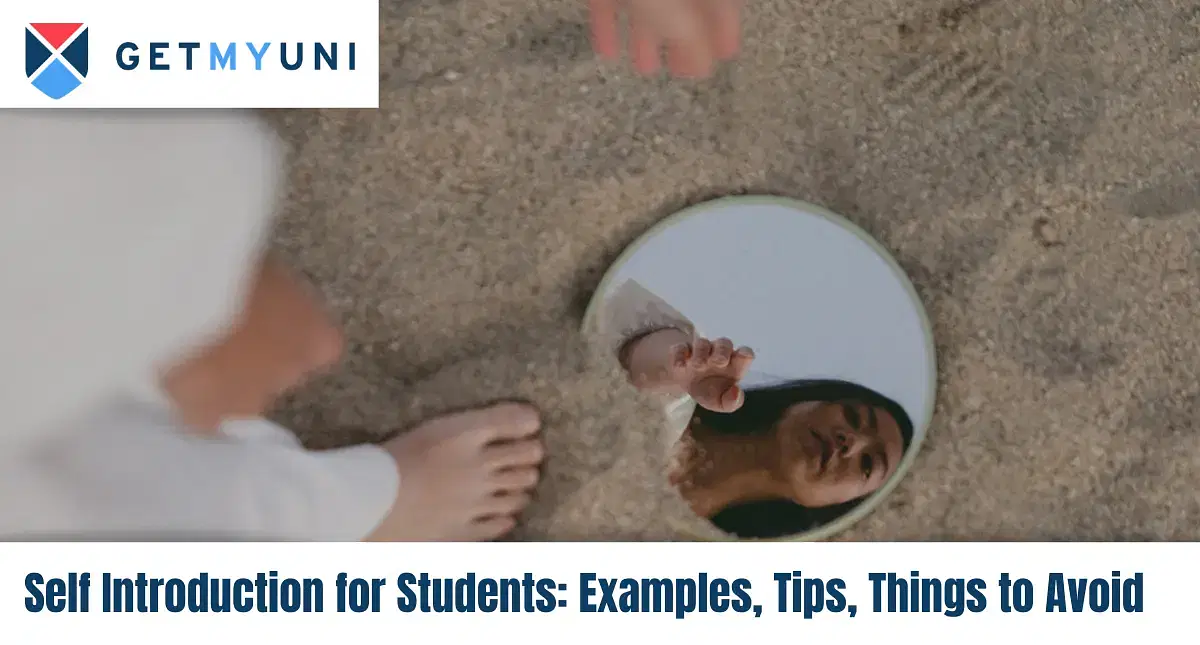
A self-introduction is a brief statement or remark that a person gives to others to introduce themselves. It allows them to provide vital details about themselves, such as their name, background, hobbies, and objectives.
It ought to explain the student's identity, and personality, and what attributes of the students should be known to the audience. A student's self introduction includes the name and essential details about them.
Besides, they also include facts creating an ideal impression of the person. A good self introduction for students will help them get new acquaintances and network with more people.
Table of Contents
- Examples of Self Introduction for Students
Steps to Draft a Good Self Introduction for Students
- Key Elements of Self Introduction for Students
- Important Tips for Self Introduction for Students
What is Self Introduction?
Importance of self introduction for students.
- Things to Avoid During Self Introduction for Students
- How to Practice Self Introduction?
- Books for Enhanced English
Examples of Self Introduction for Students
Self Introduction is essential to have clear communication. The students should be able to communicate freely and make an effort to address the audience smartly. Below are the best self introduction example for students.
- Example 1: Self Introduction for students during a college interview
- Example 2: Self Introduction for students to a team
- Example 3: Classroom Self Introduction for students
Example 1: Self Introduction for Students during a College interview
Good morning Sir/Ma'am,
I am Amogh, born and brought up in Bandra. Thank you for allowing me to introduce myself. I scored 77% in my school at Little Flowers Montessori English Medium High School. I scored 77.7% at SSWN Junior College.
I believe my strength is my attitude, and I like to take up challenges and think to accept both success and failure in a balanced way to move forward. I want to say that I don't leave any questions altogether as I believe in myself and my work.
My short-term goal is to find my area of interest in various clubs that the college organized. And my long-term goal is to get placed in a high-paying position and a holistic work environment that allows me to learn and implement my ideas. That's all about me, sir.
Thank you for providing me with such an excellent opportunity to introduce myself.

Also Check : 10 Prioritization Techniques for Student Productivity
Example 2: Self Introduction for Students to a Team
Good morning Ma'am/Sir,
I'm Shree, and it's my pleasure to introduce myself. I was born in Himachal Pradesh and grew up in Anandpur. I did my schooling at Little Flower Montessori English Medium High School and am now pursuing my B.Tech from CBT.
My strength is that I am always ready to take up new challenges and strive for excellence. This is because I believe success and failures are the best way to sculpt ourselves to reach our goals. And I believe in myself and my hard work and want fulfillment in everything.
My short-term goal is to achieve excellence in the skills I'm mastering. However, my long-term goal is to be a renowned Technical Engineer. That's all about me, sir. Thanks for allowing me to introduce myself.

Also Check : Skill Development Courses List for Students
Example 3: Classroom Self Introduction for Students
Hi everyone,
My name is Akhil, and I come from Anna Nagar, Chennai. I am 12 years old, and I look forward to being a part of this classroom. I am interested in coin collecting and collecting different-sized and shaped leaves, so when I am outside of the classroom and not engaged in academic activities, I usually engage in my hobby.
My favorite subjects in school are History and my favorite extracurricular activities include painting and pencil sketching.
I am excited to be here with you and can't wait for us to learn together. Please feel free to approach me with any questions you might have. Thank you for listening to me!
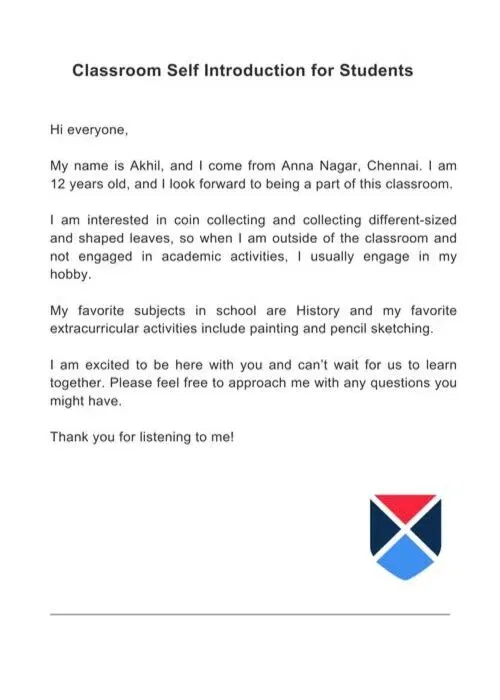
Also Check : 6 Coping Strategies For Student Mental Health
The students can get to know how to draft a good self introduction using the step-by-step guide given below to frame an effective and powerful self introduction amongst the group of audience.
- Step 1: Create an outline of the self introduction
The students must create a synopsis or outline of the self introduction with the crux on what points they are going to include in their self introduction. It will help them decide on what is worth saying and what is not.
- Where the student is from?
- Educational background (degree or class with the institutions name)
- Interests or Hobbies / Life goals (short and long-term)
- Why the student chose to be there that day?
- Exciting call to action
- Ending greetings
- Step 2: Two points for each header in outline
The students can write two format of points on each header mentioned in the outline to understand which format works better for them. The formats could be formal and informat or semi-formal.
- Step 3: Selecting the points from each header
Once the students selects the format (formal, informal, or semi-formal) they'll have to go with the same throughout the self introduction. It is important to stay on track to have an effective and good self introduction for the students to make a confident first impression.
- Step 4: Check the tone of voice and grammar
The students ought to check the tone of voice since it will decide their image and personality in the long run. The self introduction has to be polite and attention worthy. They can also use free online tools to check the grammar of the content to be spoken out.
- Step 5: Speak it out loud
The students last step is to speak the self introduction out loud to decide on the timings, the sentence formation, the order of the points spoken during the self introduction etc. Speaking it out loud will help the students to add or remove points to make the self introduction more attractive.
Also Check : Top 10 Most Effective Stress Management Techniques for Students
Key Elements of Self Introduction for Students
The students must note the key elements to be addressed while performing a self introduction. The pointers are as follows;
- The students will have to mention their full names.
- They have to mention their educational qualification and the institution in which it was pursued.
- If the student is performing a self introduction during an interview then they will have to mention their short-term and long-term goals (one each).
- Practice short 1 minute self introductions to be more concise.
- The students must conclude by being polite and summarizing a good word or two about the introduction experience.
Important Tips for Self Introduction for a Student
The self introduction for students must be impactful, as it is the chance to create a first impression. The points expressed while giving the self introduction must be precise and clear. It is not necessary to include any trivial information to fill in the gaps in the conversation. Find the list of points and tips for a self introduction for students to make an excellent first impression.
- Remember always to wish: By wishing good morning or good evening, a person initiates a conversation and grabs the listeners' attention. It would be better if a student looked confident while starting a conversation.
- Have a purpose: It is necessary to have a better understanding of the motive behind the conversation. Always try to make the conversation impactful and engaging.
- Provide a name: Start by telling your name in a lively voice to make them remember the following words spoken by a particular person.
- Profession: Tell about your work experience, career, or anything related to work. Sometimes it's okay to exclude work experience in the self introduction for students. However, if there are any internships or part-time jobs, students can include those too.
- Location: Speak about your background and area of residence. One may include a native place and tell about its specialty to help them remember the site.
- Hobbies: One may tell them about hobbies, areas of interest, and activities one gets involved in. This can help to know about nature and lifestyle.
- Aims: Mention the objective of life and give a detailed description
- Discuss achievements: Include one's achievements in the introduction, and mention what one has achieved till now. Besides, give 3-5 descriptive achievements in the introduction to make it look impactful.
- Favorite or ideal persons: Include one's perfect person in the introduction, and talk about the reason why they motivate you.
- Favorite things, colors, and movies: If the introduction is casual, students may feel free to tell their favorite movies and other favorite places, colors, etc.
- Strengths and weaknesses: Mention strengths and weaknesses in a self introduction, make sure not to include major flaws, and give a detailed description of the strengths possessed.
- Discuss likes and dislikes: One may include their personal preferences or dislikes in the introduction.
- Any life-changing point: Students may include life-changing moments if students want the listeners to engage in their talk.
- Differentiation: In one's introduction, students should speak about their uniqueness and what makes them stand out, which is the essential aspect of self introduction.
- Conclusion: In conclusion, offers an unforgettable answer to the question the spectators possibly will have when they listen to a public speech: what's in it for me? Describe how different life experiences molded your personality, which will be the perfect ending of the self introduction for students.
- Greeting: Say thank you and exit.
Also Check : 10 Tips for Staying Focused and Productive as A Student
A Self Introduction is a way of introducing oneself to others. It is a brief statement that gives an overview of who you are, where are you from, what you do, and other highlights required.
Self Introduction usually happens when a person is anchoring an event, starting a new job, joining an organization, or meeting new people in social gatherings. A Self Introduction typically includes one's name, profession, education, or field of study and a brief overview of their background and forum-based interests.
Self Introduction for students means introducing and describing themselves in a justified manner. It means highlighting all their unique attributes, and it would be best to be confident and clear enough while introducing themselves to others. A good Self Introduction for students must include the following,
- While introducing yourself, start with a smile on your face and greet the person or audience to whom you are introducing yourself.
- Begin with your 'Name and Place' after the greeting. And if necessary, add family details to the introduction.
- Be brief about educational details, from sharing areas of interest and hobbies to ideas and inspiration.
- Share your prior experience (if any) and recreational activities.
- Give details about the skills.
- Share past experiences, and finally, express your gratitude.
How Important is Good Self Introduction?
A good self introduction for students creates an everlasting impression, and people might be urged to listen to or talk to the person introducing themselves. It builds confidence and enhances one's ability to meet new people and presents themselves well, and makes the atmosphere contended and comfortable having a conversation. It makes a good impression on others. Knowing how to introduce ourselves helps "break the ice" when meeting new people in any place or situation.
Only an individual can know who they are, and it is essential to convey the same to let others know about themselves. By knowing ourselves, one might build enough confidence to face the world in any situation. Thus, one can work solely on producing a masterpiece and develop a positive approach to life.
Also Check : List of 10 Novels for Students to Read
Advantages of Self Introduction
This Self Introduction for students helps build a persona and creates an impactful impression on the people one addresses. Students can grab attention and peak interest with a strong introduction. Below are the advantages of self introduction for students:
- Helps build connections.
- Enhances self-confidence.
- Sharpens presentation skills.
- Builds a favorable impression.
- Enhances the ability to meet people.
- Deep understanding.
- Positive thinking.
- Generated motivation.
- Enhances communication skills.
- One could learn and improve through Self Introduction.
Things to Avoid During Self Introduction for Students
The students must know the things to avoid during self introduction to be projected for confidence and make a good first impression;
- Avoid being too casual or informal while being self introduction.
- Avoid being disrespectful to the person opposite you.
- Avoid a super lengthy introduction instead try a 1 minute self introduction.
- Avoid repeating the contents of your CV or resume.
- Avoid sharing too much personal information.
- Avoid fidgeting while sitting or standing during self introduction.
Also Check: 10 Healthy Habits for Students to Excel in Studies
How to Practice Self Introduction?
The students must practice pointers before self-introducing in public forum. These pointers and tips will help the students to be more conscious during their self introduction.
- Practice and prepare ahead of time before the actual self-introducing event.
- Pay attention to your body language and tone of voice during self introduction.
- Use simple and clear language while introducing yourself.
- Keep practicing until you perfect the speech in front of the mirror to be more self-aware.
- Keep eye contact with the group while introducing yourself.
- Keep a timer while practicing your self introduction and cut short the speech if necessary.
Books for Enhanced English
An impactful self introduction for students includes all the essential details to create an everlasting impression. In addition, students can always refer to and practice with books to improve their language skills. Below is the list of books for enhanced English.
Also Read: Smarter Study Tips for Students to Ace Their Management Exams
What is the time limit for self introduction for students?
How many points does a self introduction for students require?
What is the importance of Self Introduction for students?
POST YOUR COMMENT
Related articles.

IIIT Fee Structure 2024: Get updated Fees & Eligibility

List of MCA Colleges in Kolkata Without JECA

BSc Nursing Entrance Exams 2024: Important Dates, Application Form, Eligibility, Top Colleges

BITS Pilani Direct Admission 2024: Process & Courses Offered
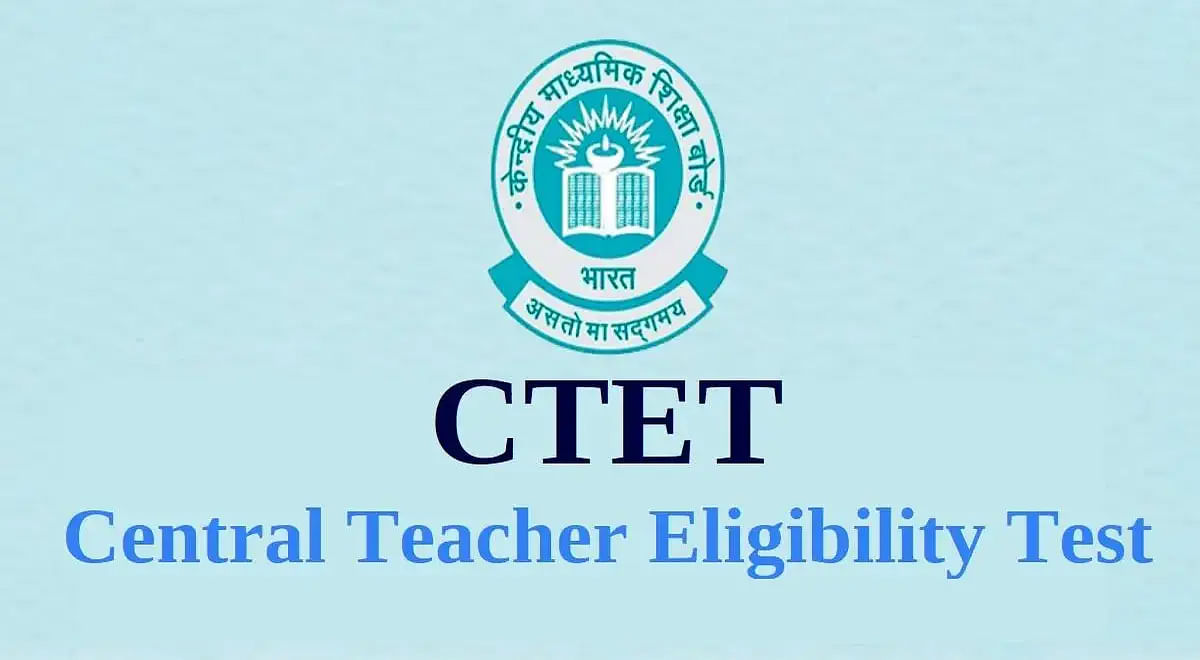
Last Minute Revision Tips for CTET 2024

Top 10 Merchant Navy Colleges in India

Osmania University Grading System 2024: Get Passing Marks & Grade Points
Get Free Scholarship worth 25000 INR
- Self Introduction
- Start Conversation
- Self Introduction Generator
- Introduction in Other Languages

27 Examples of Self Introduction in English For Great First Impression – Introduce Yourself In English
Telling someone about yourself can be tricky if you’re not sure how to go about it, but when you’re in an interview or at the start of your first day on the job, giving someone an overview of your previous work and education experience isn’t only necessary – it shows that you’re excited to be there and prepared to work hard.
Here are some examples of self introduction in English that you can use to introduce yourself.
You can check the video to learn more..
Self Introduction in English Examples
Example 1:
Hello, my name is [name] and I am writing to introduce myself. My interests include photography, art, and music. I enjoy making things out of clay and woodworking.
I am a native of the United States and have been here for over 20 years now. I grew up in [city] where I attended school. After high school, I moved to [state] where I went to college at [school name].
During college, it was not easy for me to make friends because I was shy and quiet. It wasn’t until after college when I started working at [job title], that my relationships with others changed for the better. At work, I was able to open up more as well as learn how to communicate better with others by using body language and tone of voice rather than words alone. This resulted in me being promoted from a part-time employee into an assistant manager position within two years of working there full-time!
Hello, I’m [first name], and I’m a writer.
I’ve been writing for a while now, and it’s become an integral part of my life. My passion for writing started when I was in elementary school. I got a pen and paper and wrote down everything that popped into my head—I couldn’t stop!
As my writing skills improved, so did my confidence as a writer. At first, people thought I was just a kid with a lot of energy; but now they see that writing is more than just something fun to do—it’s something that makes me happy, and gives me clarity on what I want out of life, and helps me make sense of the world around me.
So if you’re interested in hiring me as your writer or if you have any questions about what it’s like to work with me, please feel free to reach out!
Hi, I’m [name] and I work at [company] as a [job title]!
I’m a recent college graduate and have been working in customer service for the past six months. I’m looking for opportunities to learn more about the customer service field and grow my skills to take on more challenging roles.
[Company name] provides the best customer service in the world, and I am excited to join such an amazing team.
Self Introduction Paragraph Examples
My name is [name], and I’m a [type of person].
I love to [what you love to do].
When I’m not working or doing what I love, my friends and family are the most important thing in my life. They mean the world to me. When they’re around, I feel like everything is possible.
I’m currently in my final year of university, and it’s been one of the most amazing years of my life so far. I’ve learned so much about myself and how to be a better person, which has made me feel more confident than ever before.
Hi! I’m [name] and I’m so excited to meet you all.
I’m a passionate, driven person who wants to do my part to make the world a better place. That’s why I’m here at [company name].
I’ve got a lot of experience working in customer service, but I also have a passion for helping people find their best path forward when they’re faced with challenges. And that’s what we’re working on at [company name]: finding those solutions for our clients so they can focus on what matters the most—their business.
I’m looking forward to getting to know you all!
- 3 Examples of Self Introduction to a Landlord
- 9 Examples of Self Introduction For Pharma Interview
Hi, my name is [name], and I’m here to tell you about my [job].
I’ve been working as a [job] for [number of years], and I love it. It’s an amazing job that allows me to do what I love most—make people happy!
My favorite part of my job is seeing how much happiness can be brought into someone’s life when they’re feeling down or stressed out. I know that by helping people feel better, we’re all better off as a community.
I also really enjoy meeting new people every day who need support in their journey through life. Being able to share what I know with them has helped me grow personally and professionally, so thank you for your support!
Self Introduction Speech Examples For Students
Hi, my name is [name], and I’m about to give you a self-introduction speech.
I’m going to tell you about myself in three parts: who I am, what I’ve done, and why I should be hired for this job.
First, let’s talk about who I am: I’m [age] years old. I’ve been working as a [job title] for [amount of time]. And I love it! It’s made me very good at what I do and keeps me busy all day long.
And now let’s talk about what I’ve done…
I started working at the company when they were just starting, and now they’re one of the top 10 companies in our industry. They’re growing so fast that there are times when we can’t keep up with hiring new people or training them properly. That’s where you come in—you’re going to help us hire some awesome new people who are ready to hit the ground running!
And finally, why should you hire me? Well… because if this were a movie script, there would be no way for me not to get hired by your company!
Hello, my name is [name] and I am a student at [school].
I am interested in pursuing a career in the field of [industry], and I would like to study [field] at [school].
My current job is working as a marketing assistant for [company], where I handle all the emails and calls from clients, as well as manage our social media accounts.
I have been working in this position for over three years now, and it has greatly improved my skillset in terms of customer relations and communication abilities. I would love to continue working for [company] after graduating from college with a degree in both marketing and business management.
Hello, my name is [name] and I’m a student at [school name].
I have always loved to learn and explore, so when I was in the 8th grade I started taking classes at my local college. Now, I have many different degrees from various programs and am heavily involved in the community at large.
In my free time, I enjoy spending time with family, and friends and doing things that make me happy. One of those things is hiking!
Self Introduction Sample For Nurse Job Interview
Hi, I’m [name], and I hope to be the next one of you awesome nurses!
I have a bachelor’s degree in nursing and am currently working as a nurse at [hospital name]. I’ve worked in many different areas, including ER, ICU, and medical-surgical. I love working with patients from all walks of life, but my favorite part is taking care of babies because they’re so sweet and innocent.
I also enjoy helping others learn about their health, whether it’s through patient education or offering advice on dieting or exercise.
Hello, I’m [name] and I’m a nurse. I’ve been in the industry for many years and have worked with many different kinds of patients. I am looking to move into a leadership position, preferably with a hospital or nursing home to manage more than one unit. I believe that the most important part of my job is making sure that my patients are comfortable in their care environment and feel safe at all times. I also enjoy working with other staff members because they can help me access different areas of expertise, which makes me a better nurse and leader.
I would love an opportunity to discuss how my experience could benefit your organization!
Hello, I’m [name] and I’m looking for a job as a nurse.
I’m a middle school student who loves to help people. I’ve had experience working at [hospital name] and [hospital name], where I helped children get better after they were injured.
I also love volunteering at the local animal shelter, where I’ve helped an elderly cat named [cat name]. The owner of the shelter said that she couldn’t find a home for her because she was old, but after working with her, I realized that she was still young at heart.
The hospital where I work now is great and everyone there is very nice, but it’s not the same as being able to help people. It’s hard for me to watch someone get hurt or sick on my shift—especially when there’s nothing that I can do about it—and I want something more for myself than just working in healthcare.
Self Introduction Speech Examples For School Students
Hello! My name is [name], and I’m here to introduce myself to the class.
I’m from [city] in [country]. I’ve been living in the United States for five years now, but I’ve been here for seven. I love this country, and I love being able to learn more about it every day.
In high school, I was a really good student—I got straight A’s all the time. But during my senior year, one of my teachers taught us how to write a speech about ourselves—and that’s when everything changed. Now when someone asks me what I want to be when I grow up, instead of saying “an accountant,” like everyone else says, I say “a teacher.”
So this is me: A teacher who has learned so many things since she started working with children at the age of 18. And now at age 32, she has even more knowledge than she did before!
Hello, my name is [name], and I’m a student at [school name].
I’m excited to be here today because I’ve been wanting to go to this school for a long time. My favorite subject is math, so it’s cool that there will be an opportunity for me to learn more about that.
I also love reading a lot of books and watching movies, so I think this is going to be a good fit for me.
My parents are very supportive of my dreams and help me whenever they can. They always make sure that I am doing what I want, so if you have any questions about anything related to school or your studies, feel free to ask them!
Hello, everyone! I’m [name], and I was just thinking about what to say.
I think that you’re all really smart and kind, and it’s a pleasure to meet you!
My name is [name] and I’m going to be taking your next test. Hopefully, we’ll get along well enough to make it interesting.
I’m here today because I want to talk about [topic]. It’s important to me because it affects my life every day, but also helps me think about things that are important in the world.
Self Introduction Speech Examples Public Speaking
I am a passionate person, who loves to learn and share knowledge with others. I believe that every person should be treated equally, no matter their gender, race, or religion.
I have always dreamed of becoming an entrepreneur. I have been working in the field for the last 6 years and it has become my passion now.
I have completed my MBA from St. Xavier’s College and I worked as an Assistant Manager in a reputed company for 4 years before joining here at [company name].
Hello, my name is [name] and I am a [job title]. I have been working as a [job title] for [number of years] and I have been enjoying every moment of it.
I have always had a passion for [job title], and it is truly an honor to be able to work with such amazing people.
I have been lucky enough to work with some of the most talented people in the world, including [famous person’s name], who has taught me so much about [job title].
I would like to thank you all for this opportunity because it has helped me grow both personally and professionally. It has brought me closer to my family and allowed me to meet new people who share similar interests.
Hi, I’m [name], and I’m a professional speaker.
I’ve been giving speeches for over 10 years, and I love it.
My favorite part is being able to share what I know with other people engagingly. It’s also really fun to meet new people and hear their stories because then I can learn from them too!
I also like that people are usually surprised when they find out how much time goes into preparing for a speech—it’s not just about speaking fast or moving your mouth around—but about making it personal and interesting for your audience.
If you have any questions about anything related to public speaking, feel free to contact me at [email address].
Self Introduction Sample For Hr Interview
Hello, I’m [name], a junior HR professional at [company name]. I’m interested in the position of HR Manager, and I’m here today because I think you’re the right person for it.
I have a Bachelor’s degree in Human Resources and a Master’s degree in Personnel Management, both from [school name]. My interests include [interests], which are things like [things], which are things like [things].
In my spare time, I enjoy watching sports on TV and playing volleyball with friends at the local park.
Hello, I’m [name] and I’m a [position] at [company name]. I love to work hard, which is why I’m so excited to be here.
I’ve been working with [company name] for years now, and it’s been an amazing experience. I’ve been able to learn so much about myself and the company in that time.
I’d love to talk more about my experience with you! Please feel free to reach out if you’d like any additional details or want me to send you anything from HR.
Hello! I’m [name], and I would be happy to answer any questions you have about my qualifications for this position.
I have a bachelor’s degree in computer science, but I’ve also spent the past six years working as a software engineer. In my current role, I’m responsible for building, maintaining, and improving our software products.
Throughout my career, I’ve worked with engineers from all over the world who have taught me how to problem-solve creatively and work well with others. My experience with developers at [company name] has given me an understanding of what it takes to build quality products that meet our customers’ needs.
The skills listed on my resume are just a small representation of the competencies that make me a great fit for this position:
– Able to build robust, scalable systems that meet customer needs and respond quickly to change
– Able to communicate effectively with other team members
Self Introduction Examples For Experienced Software Engineers
Hello, I am [name], and I am an experienced software engineer.
My specialty is in creating high-quality, well-tested code that solves business problems for my clients. I have been working with them for about five years, and have also worked as a freelance software engineer for several other companies during that time.
I have a Bachelor’s degree in Computer Science from [school name]. After graduating, I worked as a software developer at [company name] for two years. During this time, I learned how to contribute my skills to the company by making contributions within the company’s code base. After working at [company name], I decided to pursue a career as a freelancer and started freelancing immediately.
As a freelancer, my primary focus has been working on projects related to building web applications using mostly JavaScript-based technologies such as HTML5+CSS3/SASS/LESS/JAVASCRIPT (JS) frameworks like ReactJS or VueJS, or NodeJS (server side). However, I have worked with the PHP framework (Laravel) on some projects too.
Hi! I’m [Name] and I’m a software engineer at [company name]. I’ve been working in this industry for six years now, and it’s always been my dream to be in the field. When I graduated from college, I started working as a developer at one of the country’s largest consulting firms. After two years there, I decided to move on and pursue my dream of being a software engineer—and here I am today!
I love what I do because it allows me to work on some cool projects. One of my favorite parts of being a software engineer is working with clients and helping them improve their products. It’s also very rewarding when you see how your work helps people take control of their lives or businesses.
I am a software engineer with over 10 years of experience. I have worked on many different projects, including web development, mobile applications, and backend systems.
My strengths are in designing and implementing scalable solutions while maintaining high-quality standards. I am also very good at communicating my ideas effectively and creating solutions that meet the needs of my clients. I have worked in teams to develop solutions that are both functional and aesthetically pleasing.
I would love to work on projects that allowed me to use my skills and knowledge to help solve real problems for people in our community.
Self Introduction Sample For Virtual Assistant
My name is [your name here]. I am the founder of [company name] and I have been a virtual assistant for 10 years.
I love helping people with their problems and helping them grow their businesses. I’m also a huge fan of dogs, serial killers, and the Harry Potter series.
Example 2:
I’m [name], and I’m a virtual assistant and web developer based in [location].
I bring over 15 years of experience as a web developer, working with both small and large businesses, to assist you in getting your projects off the ground. Whether you need help building websites, or just need someone who can manage your social media, my background as a web developer will help me keep you informed, on track, and able to stay focused on your goals.
I have experience working with clients from all over the world and am always looking forward to helping others achieve their goals.
Example 3:
Hello, I’m [name] and I’m a virtual assistant.
I’ve been working as a VA for over [years] now, and I love it! I work with people who are looking to get their business off the ground, or who just need some extra help around the house. My clients are always happy with my work.
In addition to being a VA, I’m also an avid reader and writer. I enjoy helping others in any way that I can—whether it’s by offering advice or helping them write their copy for landing pages or emails.
I’ve worked on projects ranging from simple blog posts to complex web applications (both front-end and back-end), so whatever your project requires, you’ll find me very capable of handling it.
Related Questions:
Can an introduction be one sentence.
Yes. Just give your name and then your question. There is no reason to list all your credentials first. That’s boring and drawn out. You should know about the community that you’re applying for. You don’t need to list the fact you are a school teacher, that you have a degree in English, that you have a spouse and 2 kids. All of that stuff is irrelevant when it comes to what you want to know, and you’re just wasting space.
Can Introduction Be Two Paragraphs?
Yes. The introduction is a paragraph. That’s the whole rule. With that said, it can be two paragraphs, it can be ten paragraphs, and it can be a page. The length of your introduction is dependent on several factors: who you are writing for, how much time you have to write, how detailed you want to get, and how much detail your reader can absorb.
With that said, let’s take a look at a few examples of great introductions: 1. This is the best, most concise introduction I’ve ever read. Not only is the information short and sweet, but it gets right to the point and shows exactly what the reader has to do, and why it’s important.
The Verdict: Self Introduction Examples
Choose a template that you like, edit it and make it your own. When you’re done, add your photos to the design. Present yourself to the world with these stunning, professional designs for your self introduction. And as always, please feel free to contact me if you have a question or would like to give feedback on this article.
Hi, I a Usmaan Ali, a content writer. I’ve always been passionate about writing and blogging. I hope you enjoy my blog posts as much as I enjoy writing it!
Related Posts
5+ examples of business self introduction email, self introduction in interview for experienced candidates, self introduction for medical representative interview, leave a reply cancel reply.
Save my name, email, and website in this browser for the next time I comment.
Type above and press Enter to search. Press Esc to cancel.


Get science-backed answers as you write with Paperpal's Research feature
How to Write an Essay Introduction (with Examples)

The introduction of an essay plays a critical role in engaging the reader and providing contextual information about the topic. It sets the stage for the rest of the essay, establishes the tone and style, and motivates the reader to continue reading.
Table of Contents
What is an essay introduction , what to include in an essay introduction, how to create an essay structure , step-by-step process for writing an essay introduction , how to write an introduction paragraph , how to write a hook for your essay , how to include background information , how to write a thesis statement .
- Argumentative Essay Introduction Example:
- Expository Essay Introduction Example
Literary Analysis Essay Introduction Example
Check and revise – checklist for essay introduction , key takeaways , frequently asked questions .
An introduction is the opening section of an essay, paper, or other written work. It introduces the topic and provides background information, context, and an overview of what the reader can expect from the rest of the work. 1 The key is to be concise and to the point, providing enough information to engage the reader without delving into excessive detail.
The essay introduction is crucial as it sets the tone for the entire piece and provides the reader with a roadmap of what to expect. Here are key elements to include in your essay introduction:
- Hook : Start with an attention-grabbing statement or question to engage the reader. This could be a surprising fact, a relevant quote, or a compelling anecdote.
- Background information : Provide context and background information to help the reader understand the topic. This can include historical information, definitions of key terms, or an overview of the current state of affairs related to your topic.
- Thesis statement : Clearly state your main argument or position on the topic. Your thesis should be concise and specific, providing a clear direction for your essay.
Before we get into how to write an essay introduction, we need to know how it is structured. The structure of an essay is crucial for organizing your thoughts and presenting them clearly and logically. It is divided as follows: 2
- Introduction: The introduction should grab the reader’s attention with a hook, provide context, and include a thesis statement that presents the main argument or purpose of the essay.
- Body: The body should consist of focused paragraphs that support your thesis statement using evidence and analysis. Each paragraph should concentrate on a single central idea or argument and provide evidence, examples, or analysis to back it up.
- Conclusion: The conclusion should summarize the main points and restate the thesis differently. End with a final statement that leaves a lasting impression on the reader. Avoid new information or arguments.

Here’s a step-by-step guide on how to write an essay introduction:
- Start with a Hook : Begin your introduction paragraph with an attention-grabbing statement, question, quote, or anecdote related to your topic. The hook should pique the reader’s interest and encourage them to continue reading.
- Provide Background Information : This helps the reader understand the relevance and importance of the topic.
- State Your Thesis Statement : The last sentence is the main argument or point of your essay. It should be clear, concise, and directly address the topic of your essay.
- Preview the Main Points : This gives the reader an idea of what to expect and how you will support your thesis.
- Keep it Concise and Clear : Avoid going into too much detail or including information not directly relevant to your topic.
- Revise : Revise your introduction after you’ve written the rest of your essay to ensure it aligns with your final argument.
Here’s an example of an essay introduction paragraph about the importance of education:
Education is often viewed as a fundamental human right and a key social and economic development driver. As Nelson Mandela once famously said, “Education is the most powerful weapon which you can use to change the world.” It is the key to unlocking a wide range of opportunities and benefits for individuals, societies, and nations. In today’s constantly evolving world, education has become even more critical. It has expanded beyond traditional classroom learning to include digital and remote learning, making education more accessible and convenient. This essay will delve into the importance of education in empowering individuals to achieve their dreams, improving societies by promoting social justice and equality, and driving economic growth by developing a skilled workforce and promoting innovation.
This introduction paragraph example includes a hook (the quote by Nelson Mandela), provides some background information on education, and states the thesis statement (the importance of education).
This is one of the key steps in how to write an essay introduction. Crafting a compelling hook is vital because it sets the tone for your entire essay and determines whether your readers will stay interested. A good hook draws the reader in and sets the stage for the rest of your essay.
- Avoid Dry Fact : Instead of simply stating a bland fact, try to make it engaging and relevant to your topic. For example, if you’re writing about the benefits of exercise, you could start with a startling statistic like, “Did you know that regular exercise can increase your lifespan by up to seven years?”
- Avoid Using a Dictionary Definition : While definitions can be informative, they’re not always the most captivating way to start an essay. Instead, try to use a quote, anecdote, or provocative question to pique the reader’s interest. For instance, if you’re writing about freedom, you could begin with a quote from a famous freedom fighter or philosopher.
- Do Not Just State a Fact That the Reader Already Knows : This ties back to the first point—your hook should surprise or intrigue the reader. For Here’s an introduction paragraph example, if you’re writing about climate change, you could start with a thought-provoking statement like, “Despite overwhelming evidence, many people still refuse to believe in the reality of climate change.”
Including background information in the introduction section of your essay is important to provide context and establish the relevance of your topic. When writing the background information, you can follow these steps:
- Start with a General Statement: Begin with a general statement about the topic and gradually narrow it down to your specific focus. For example, when discussing the impact of social media, you can begin by making a broad statement about social media and its widespread use in today’s society, as follows: “Social media has become an integral part of modern life, with billions of users worldwide.”
- Define Key Terms : Define any key terms or concepts that may be unfamiliar to your readers but are essential for understanding your argument.
- Provide Relevant Statistics: Use statistics or facts to highlight the significance of the issue you’re discussing. For instance, “According to a report by Statista, the number of social media users is expected to reach 4.41 billion by 2025.”
- Discuss the Evolution: Mention previous research or studies that have been conducted on the topic, especially those that are relevant to your argument. Mention key milestones or developments that have shaped its current impact. You can also outline some of the major effects of social media. For example, you can briefly describe how social media has evolved, including positives such as increased connectivity and issues like cyberbullying and privacy concerns.
- Transition to Your Thesis: Use the background information to lead into your thesis statement, which should clearly state the main argument or purpose of your essay. For example, “Given its pervasive influence, it is crucial to examine the impact of social media on mental health.”

A thesis statement is a concise summary of the main point or claim of an essay, research paper, or other type of academic writing. It appears near the end of the introduction. Here’s how to write a thesis statement:
- Identify the topic: Start by identifying the topic of your essay. For example, if your essay is about the importance of exercise for overall health, your topic is “exercise.”
- State your position: Next, state your position or claim about the topic. This is the main argument or point you want to make. For example, if you believe that regular exercise is crucial for maintaining good health, your position could be: “Regular exercise is essential for maintaining good health.”
- Support your position: Provide a brief overview of the reasons or evidence that support your position. These will be the main points of your essay. For example, if you’re writing an essay about the importance of exercise, you could mention the physical health benefits, mental health benefits, and the role of exercise in disease prevention.
- Make it specific: Ensure your thesis statement clearly states what you will discuss in your essay. For example, instead of saying, “Exercise is good for you,” you could say, “Regular exercise, including cardiovascular and strength training, can improve overall health and reduce the risk of chronic diseases.”
Examples of essay introduction
Here are examples of essay introductions for different types of essays:
Argumentative Essay Introduction Example:
Topic: Should the voting age be lowered to 16?
“The question of whether the voting age should be lowered to 16 has sparked nationwide debate. While some argue that 16-year-olds lack the requisite maturity and knowledge to make informed decisions, others argue that doing so would imbue young people with agency and give them a voice in shaping their future.”
Expository Essay Introduction Example
Topic: The benefits of regular exercise
“In today’s fast-paced world, the importance of regular exercise cannot be overstated. From improving physical health to boosting mental well-being, the benefits of exercise are numerous and far-reaching. This essay will examine the various advantages of regular exercise and provide tips on incorporating it into your daily routine.”
Text: “To Kill a Mockingbird” by Harper Lee
“Harper Lee’s novel, ‘To Kill a Mockingbird,’ is a timeless classic that explores themes of racism, injustice, and morality in the American South. Through the eyes of young Scout Finch, the reader is taken on a journey that challenges societal norms and forces characters to confront their prejudices. This essay will analyze the novel’s use of symbolism, character development, and narrative structure to uncover its deeper meaning and relevance to contemporary society.”
- Engaging and Relevant First Sentence : The opening sentence captures the reader’s attention and relates directly to the topic.
- Background Information : Enough background information is introduced to provide context for the thesis statement.
- Definition of Important Terms : Key terms or concepts that might be unfamiliar to the audience or are central to the argument are defined.
- Clear Thesis Statement : The thesis statement presents the main point or argument of the essay.
- Relevance to Main Body : Everything in the introduction directly relates to and sets up the discussion in the main body of the essay.

Writing a strong introduction is crucial for setting the tone and context of your essay. Here are the key takeaways for how to write essay introduction: 3
- Hook the Reader : Start with an engaging hook to grab the reader’s attention. This could be a compelling question, a surprising fact, a relevant quote, or an anecdote.
- Provide Background : Give a brief overview of the topic, setting the context and stage for the discussion.
- Thesis Statement : State your thesis, which is the main argument or point of your essay. It should be concise, clear, and specific.
- Preview the Structure : Outline the main points or arguments to help the reader understand the organization of your essay.
- Keep it Concise : Avoid including unnecessary details or information not directly related to your thesis.
- Revise and Edit : Revise your introduction to ensure clarity, coherence, and relevance. Check for grammar and spelling errors.
- Seek Feedback : Get feedback from peers or instructors to improve your introduction further.
The purpose of an essay introduction is to give an overview of the topic, context, and main ideas of the essay. It is meant to engage the reader, establish the tone for the rest of the essay, and introduce the thesis statement or central argument.
An essay introduction typically ranges from 5-10% of the total word count. For example, in a 1,000-word essay, the introduction would be roughly 50-100 words. However, the length can vary depending on the complexity of the topic and the overall length of the essay.
An essay introduction is critical in engaging the reader and providing contextual information about the topic. To ensure its effectiveness, consider incorporating these key elements: a compelling hook, background information, a clear thesis statement, an outline of the essay’s scope, a smooth transition to the body, and optional signposting sentences.
The process of writing an essay introduction is not necessarily straightforward, but there are several strategies that can be employed to achieve this end. When experiencing difficulty initiating the process, consider the following techniques: begin with an anecdote, a quotation, an image, a question, or a startling fact to pique the reader’s interest. It may also be helpful to consider the five W’s of journalism: who, what, when, where, why, and how. For instance, an anecdotal opening could be structured as follows: “As I ascended the stage, momentarily blinded by the intense lights, I could sense the weight of a hundred eyes upon me, anticipating my next move. The topic of discussion was climate change, a subject I was passionate about, and it was my first public speaking event. Little did I know , that pivotal moment would not only alter my perspective but also chart my life’s course.”
Crafting a compelling thesis statement for your introduction paragraph is crucial to grab your reader’s attention. To achieve this, avoid using overused phrases such as “In this paper, I will write about” or “I will focus on” as they lack originality. Instead, strive to engage your reader by substantiating your stance or proposition with a “so what” clause. While writing your thesis statement, aim to be precise, succinct, and clear in conveying your main argument.
To create an effective essay introduction, ensure it is clear, engaging, relevant, and contains a concise thesis statement. It should transition smoothly into the essay and be long enough to cover necessary points but not become overwhelming. Seek feedback from peers or instructors to assess its effectiveness.
References
- Cui, L. (2022). Unit 6 Essay Introduction. Building Academic Writing Skills .
- West, H., Malcolm, G., Keywood, S., & Hill, J. (2019). Writing a successful essay. Journal of Geography in Higher Education , 43 (4), 609-617.
- Beavers, M. E., Thoune, D. L., & McBeth, M. (2023). Bibliographic Essay: Reading, Researching, Teaching, and Writing with Hooks: A Queer Literacy Sponsorship. College English, 85(3), 230-242.
Paperpal is a comprehensive AI writing toolkit that helps students and researchers achieve 2x the writing in half the time. It leverages 21+ years of STM experience and insights from millions of research articles to provide in-depth academic writing, language editing, and submission readiness support to help you write better, faster.
Get accurate academic translations, rewriting support, grammar checks, vocabulary suggestions, and generative AI assistance that delivers human precision at machine speed. Try for free or upgrade to Paperpal Prime starting at US$19 a month to access premium features, including consistency, plagiarism, and 30+ submission readiness checks to help you succeed.
Experience the future of academic writing – Sign up to Paperpal and start writing for free!
Related Reads:
- What is an Argumentative Essay? How to Write It (With Examples)
- How to Paraphrase Research Papers Effectively
- How to Cite Social Media Sources in Academic Writing?
- How Long Should a Chapter Be?
Similarity Checks: The Author’s Guide to Plagiarism and Responsible Writing
Types of plagiarism and 6 tips to avoid it in your writing , you may also like, mla works cited page: format, template & examples, how to ace grant writing for research funding..., powerful academic phrases to improve your essay writing , how to write a high-quality conference paper, how paperpal’s research feature helps you develop and..., how paperpal is enhancing academic productivity and accelerating..., academic editing: how to self-edit academic text with..., 4 ways paperpal encourages responsible writing with ai, what are scholarly sources and where can you..., how to write a hypothesis types and examples .
How to Introduce Yourself in College (as a Student)
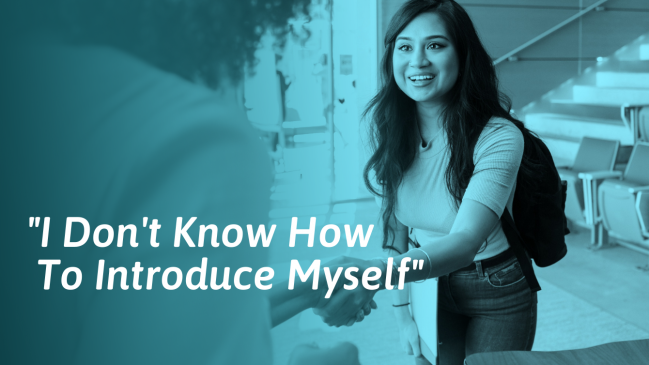
Starting college can be exciting, overwhelming—and scary. Meeting and getting to know new people on campus is one of the best ways to feel more comfortable and at ease from the first day. People who make new friends in college report having an easier time adjusting to campus life and are also more likely to still be around in their second year. [ 1 , 2 ]
Whether you are moving into a dorm, commuting to college, or taking online classes, this article can help you figure out how to introduce yourself to people in college and become part of the social scene on campus.
1. Assume you’re not the only new student
Your first day of classes can feel a lot like being the “new kid” in school who doesn’t know how to get to their homeroom class or who to sit with at lunch. It can be daunting when you don’t know anyone in your new school, but most people you meet on your first day are also new students. This means that most will be just as eager (and nervous) to meet new people as you are, which makes it easier to figure out how to approach people and make friends .
2. Craft an intro speech
Because there’s a good chance that you will get asked to introduce yourself many times in your first days in college—for example, in some of your classes—you may want to craft a brief introduction speech.
Good intros provide basic information about who you are, where you are from, and what your goals are for college, as well as providing an interesting detail or two that people can remember you by.
Here is an example of a good intro to use when first meeting other students or professors:
“Hi, my name is Carrie, and I’m originally from Wisconsin. I’m a military kid, so I’ve lived all over the US and Europe. I’m hoping to major in finance and also to study abroad.”
Practicing some words to say in specific situations can be particularly useful for transfer students. If you are one of them, take a look at this article on how to make friends as a transfer student .
3. Make a positive, intentional impression
People form first impressions of others within seconds of meeting them, with or without their knowledge. Being intentional about the impression you make helps you take advantage of these first opportunities to meet people at college.
Here are some tips on how to start a self-introduction:
- Intention : Your “goal;” what you hope to achieve by introducing yourself.
Example: Set yourself the goal of sharing more about your major (e.g., “I’m majoring in finance and would love to meet others in my department!”).
- Impression : Something you want others to remember about you.
Example: Consider making a memorable impression by sharing something interesting about yourself (e.g., “A fun fact about me is that I’m fluent in Russian”).
- Inside information : “Inside information” is what you want others to know about you.
It should give others important clues to who you are and what you are looking for in your college experience. Example: “I am from Hawaii, so this is my first time on the mainland and it’s really different! I’m still adjusting to the weather.”
4. Initiate 1:1 conversations
It can be overwhelming to introduce yourself to a class or large group of people, and it can also be difficult to form personal connections this way. Try to approach people who seem like they have things in common with you, as friendships are more likely to develop among people who are similar to each other. [ 5 ] Start by walking up, saying hello, and introducing yourself. If they seem open to talking, you can also start a more in-depth conversation by asking them questions about where they are from or how they are settling in.
5. Connect with suitemates before school starts
Being on-campus gives you a big advantage because it makes it easier to adjust and adapt to college life and also provides more natural opportunities to meet people and make friends. [ 4 ]
If you are moving into on-campus housing, consider reaching out to your suitemates before school starts by searching for them on social media or using contact information provided to you by the college.
This way, you can both go to college knowing at least one other person, which can make the first days easier. Also, connecting on social media ahead of time has been proven to make your first interactions with housemates less awkward. [ 2 ]
6. Learn people’s names
Make a point to remember the names of people you meet and talk to, and try to use their names aloud in a conversation with them. This simple trick is a proven way to help you remember names and also helps you make a positive impression on people. [ 6 ] When you know their name, it’s also easier to say hello or start conversations with them when you see them in class or around campus.
7. Talk about common struggles
Inconveniences are a part of the adjustment process to college life but also provide opportunities to naturally connect and relate to people. For example, saying, “I’ve been there!” to someone who looks lost on campus, is rushing to class, or just got a parking ticket can be a great “in” to introduce yourself. By being observant of other people, you can often find opportunities to use this approach and even offer a helping hand to someone.
8. Be active in your classes
Being active in your classes is one of the best ways to get to know your classmates while also getting to know your professors. Speaking up and sharing your input and opinions in class will help your classmates get to know you while also helping you form a good relationship with instructors. Good relationships with your professors can help open doors in your academic and professional life, as well as helping you adjust to college. [ 3 ]
9. Develop an on-campus social media presence
Research has shown that connecting with new college friends on social media can help new students build a new social life. Students who are socially connected with other students also have an easier time transitioning to college and are also more likely to still be enrolled in college the next year. [ 1 , 2 ]
You can work on building your social media presence at college by:
- Cleaning up your social media profiles by making sure pictures and posts are up-to-date and reflect the content you want others to see.
- Join social media groups with other students at your college.
- Stay up-to-date on current events and activities on campus by subscribing for updates or following university social media accounts.
- Connect 1:1 with classmates, friends, and people at your dorm on social media to message and connect directly with them.
10. Get involved in your college’s social scene
If you stay cooped up in your dorm and only come out for classes and bathroom breaks, you will have a hard time adjusting to college life. Going to on-campus events is a proven way to help students adjust, adapt, and develop an active social life in college. [ 3 , 7 ]
There are many ways to get more active and involved in on-campus activities, including:
- Consider the Greek life : Research different sororities and fraternities at your school, and consider attending a recruitment event.
- Attend campus events and socials : Attend events and socials on campus to meet new people and get oriented to campus life.
- Join a club, sport, or activity : If you have a hobby or interest, consider joining an existing club, sport, or activity at your school to meet people with similar interests.
11. Invite people out
Asking people to hang out can be difficult and intimidating but gets easier with practice. The key is to keep the invitation casual by saying something like, “Here’s my number. We should study together sometime” or, “I was thinking of going for coffee later if you feel like joining?” By taking this first step, you are showing interest in people, being friendly, and creating a chance to connect with them more personally.
12. Ask good questions
When people are nervous, they often ramble or talk too much about themselves, but one of the best ways to make conversation is to ask good questions. Asking questions is a great way to show interest in other people, which is proven to make you more likable. [ 6 ] Asking questions can also be a great way to keep a conversation going or to go deeper in a conversation and find things in common with someone .
Here are some questions to introduce yourself and find things in common with people:
- “What did you think about class today?”
- “Where are you from originally?”
- “What are you majoring in?”
- “How are you adjusting?”
- “What kinds of things do you like doing outside of class?”
13. Hone your online introduction
If you are in an online class, it’s a good idea to customize your profile in ways that help your professor and classmates get to know you. Add a photo and brief message to your profile for online classes. Also, introduce yourself to individual classmates by responding directly to their posts, messages, or online introductions. This can provide them with some validation while also giving you an easy ‘in’ to start future conversations with them.
14. Get people to come to you
You don’t have to do all of the work to introduce yourself and start conversations with people, especially if you know how to get people to come to you. According to research, being friendly, showing interest in others, and giving people your undivided attention go a long way towards making a good impression. [ 6 ] Being open and participating in classes also helps to attract people to you who share similar interests, ideas, and goals.
You can create easy opportunities for people to approach you by:
- Coming to class a few minutes early or taking your time leaving
- Studying in public areas of campus
- Attending more on-campus events
- Responding to comments of other students in classes
- Talking about your interests and opinions in classes
15. Develop an inside-out approach
People will feel more comfortable talking to you and can relate to you better when you take an ‘inside-out’ approach, letting more of your true thoughts, feelings, and personality show. [ 6 ] Often, being nervous causes people to hide their true self or put on a front or persona, but being more authentic is proven to lead to more genuine and meaningful interactions. [ 8 ]
Final thoughts
- Gray, R., Vitak, J., Easton, E. W., & Ellison, N. B. (2013). Examining social adjustment to college in the age of social media: Factors influencing successful transitions and persistence. Computers & Education , 67 , 193-207.
- Yang, C. C., & Lee, Y. (2020). Interactants and activities on Facebook, Instagram, and Twitter: Associations between social media use and social adjustment to college. Applied Developmental Science , 24 (1), 62-78.
- Terenzini, P. T., Rendon, L. I., Upcraft, M. L., Millar, S. B., Allison, K. W., Gregg, P. L., & Jalomo, R. (1994). The transition to college: Diverse students, diverse stories. Research in higher education , 35 (1), 57-73.
- Buote, V. M., Pancer, S. M., Pratt, M. W., Adams, G., Birnie-Lefcovitch, S., Polivy, J., & Wintre, M. G. (2007). The Importance of Friends: Friendship and Adjustment Among 1st-Year University Students . Journal of Adolescent Research, 22 (6), 665–689.
- Van Duijn, M. A., Zeggelink, E. P., Huisman, M., Stokman, F. N., & Wasseur, F. W. (2003). Evolution of sociology freshmen into a friendship network. Journal of Mathematical Sociology , 27 (2-3), 153-191.
- Bradberry, T. (2017). 13 habits of exceptionally likable people . HuffPost .
- Bohnert, A. M., Aikins, J. W., & Edidin, J. (2007). The Role of Organized Activities in Facilitating Social Adaptation Across the Transition to College . Journal of Adolescent Research, 22 (2), 189–208.
- Rodebaugh, T. L. (2009). Hiding the self and social anxiety: The core extrusion schema measure. Cognitive Therapy and Research , 33 (1), 90.
Hailey Shafir is a licensed mental health counselor, licensed addiction specialist, and clinical supervisor working out of Raleigh, NC. She has a Masters in Counseling from NC State University, and has extensive professional experience in counseling, program development, and clinical supervision. Read more .

“I Have No Personality” – Reasons Why and What to Do

120 Charisma Quotes to Inspire You and Influence Others

How To Be More Charismatic (And Become Naturally Magnetic)

12 Qualities That Make a Person Interesting

How To Be More Authentic And Genuine

How to Stand Out and be Memorable in Any Social Situation
Leave a comment cancel reply.
Notify me when someone responds to my comment.
To get advice relevant to you, choose below:
What is your relationship status, how would you describe your social skills, what statement best describes you, how motivated are you to deepen your friendships, how motivated are you to find like-minded friends, do you agree with this statement “i want to be more likable”, do you agree with this statement “i want to be more interesting to talk to”, do you agree with this statement “i want to be less awkward”, what best describes you, responses successfully analyzed, where should we send your personalized tips.

50 Inspiring Examples: Effective Self-Introductions
By Status.net Editorial Team on September 22, 2023 — 21 minutes to read
- Structure of a Good Self-introduction Part 1
- Examples of Self Introductions in a Job Interview Part 2
- Examples of Self Introductions in a Meeting Part 3
- Examples of Casual Self-Introductions in Group Settings Part 4
- Examples of Self-Introductions on the First Day of Work Part 5
- Examples of Good Self Introductions in a Social Setting Part 6
- Examples of Good Self Introductions on Social Media Part 7
- Self-Introductions in a Public Speaking Scenario Part 8
- Name-Role-Achievements Method Template and Examples Part 9
- Past-Present-Future Method Template and Examples Part 10
- Job Application Self-Introduction Email Example Part 11
- Networking Event Self-Introduction Email Example Part 12
- Conference Self-Introduction Email Example Part 13
- Freelance Work Self-Introduction Email Example Part 14
- New Job or Position Self-Introduction Email Example Part 15
Whether you’re navigating a job interview, networking event, or simply meeting new people, the way you introduce yourself sets the tone for the entire interaction. In this comprehensive guide, we’ll equip you with the essential tools and techniques to confidently and effectively introduce yourself in any situation, leaving a lasting and positive impression.
Part 1 Structure of a Good Self-introduction
- 1. Greeting and introduction: Start by greeting the person you’re speaking to and introducing yourself. For example, “Hi, my name is Jane. Nice to meet you!”
- 2. Brief personal background: Give a brief overview of your personal background, such as where you’re from or what you do. For example, “I’m originally from California, but I moved to New York a few years ago. I work in marketing for a tech company.” Related: 10 Smart Answers: “Tell Me About Yourself”
- 3. Professional experience: Highlight your relevant professional experience, including your current or previous job titles and any notable achievements. For example, “I’ve been working in marketing for about 5 years now, and I’m currently a Senior Marketing Manager at my company. Last year, I led a successful campaign that resulted in a 20% increase in sales.” Related: How to Describe Yourself (Best Examples for Job Interviews)
- 4. Skills and strengths: Mention any skills or strengths that are relevant to the conversation or the situation you’re in. For example, “I’m really passionate about data analysis and using insights to inform marketing strategy. I’m also a strong communicator and enjoy collaborating with cross-functional teams.” Related: 195 Positive Words to Describe Yourself [with Examples] 35 Smart Answers to “What Are Your Strengths?” What Are Your Strengths And Weaknesses? (Answers & Strategies)
- 5. Personal interests: Wrap up your self-introduction by mentioning a few personal interests or hobbies, which can help to humanize you and make you more relatable. For example, “In my free time, I love hiking and exploring new trails. I’m also a big fan of trying out new restaurants and cooking at home.”
- Related: Core Values List: 150+ Awesome Examples of Personal Values Best Examples of “Fun Facts About Me” What Are Your Values? How to Discover Your Values
Part 2 Examples of Good Self Introductions in a Job Interview
When introducing yourself in an interview, you should be confident, clear, and knowledgeable. Maintain eye contact, speak with a steady tone, and be concise. Prepare your introduction beforehand to avoid stumbling or getting too wordy. Try to cover these aspects:
- Current or most recent position/job
- A relevant accomplishment or strength
- Why you are excited about the company or role
Templates and Scripts
“Hello, my name is [Your Name], and I recently worked as a [Your Most Recent Position] at [Company/Organization]. I successfully managed a team of [Number] members, achieving a [Relevant Accomplishment or Growth]. I’m excited about the opportunity at [Interviewer’s Company] because [Reason Why You’re Interested].”
“Hi, I’m [Your Name], a [Current Job Title or Major Accomplishment]. I’m passionate about [Relevant Industry or Skillset] and have a proven track record of [Specific Result or Achievement]. I believe my skills and experience make me well-suited for this role at [Company], and I’m excited to explore how I can contribute to [Company Goal or Project].”
“Hi, my name is Jane Doe, and I’m the Assistant Marketing Manager at ABC Corp. I recently implemented a successful social media campaign, which increased engagement by 30%. I’m thrilled about the possibility of working with XYZ Inc. because of your innovative marketing strategies.”
“Hello, I’m John Smith, a financial analyst with five years of experience in the banking industry. I’ve consistently exceeded sales targets and helped my team win an award for excellent customer service. I’m excited to join DEF Ltd. because of your focus on sustainable and responsible investing.”
Remember to tailor your introduction to the specific interview situation and always show enthusiasm for the position and company. This will show the interviewer that you are the right fit.
Related: How to Describe Yourself (Best Examples for Job Interviews)
Part 3 Examples of Good Self Introductions in a Meeting
General tips.
When introducing yourself in a meeting, consider these tips:
- Start with a greeting: Begin with a simple “hello” or “good morning.”
- State your name clearly: Don’t assume everyone knows you already.
- Mention your role in the company: Help others understand your position.
- Share relevant experience or accomplishments: Give context to your expertise.
- Be brief: Save detailed explanations for later conversations.
- Show enthusiasm: Display interest in the meeting and its objectives.
- Welcome others: Encourage a sense of connection and camaraderie.
Here are some templates and scripts to use when introducing yourself in a meeting:
- Basic introduction : Hi, I’m [Name], and I work as a [Your Role] in the [Department]. It’s great to meet you all.
- Involvement-focused : Good morning, everyone. I’m [Name], [Your Role]. I handle [Responsibility] in our team, and I’m looking forward to working with you on [Project].
- Experience-based : Hello! My name is [Name] and I’m the [Your Role] here. I’ve [Number of Years] of experience in [Skills or Industry], so I hope to contribute to our discussions during the meeting.
Here are some examples of self-introductions in different scenarios:
- New team member : Hi, I’m [Name]. I just joined the [Department] team as the new [Your Role]. I have a background in [Relevant Experience] and am excited to start working with you on our projects!
- External consultant : Hello everyone, my name is [Name], and I’m here in my capacity as a [Your Role] with [Your Company]. I specialize in [Skill or Industry], and I’m looking forward to partnering with your team to achieve our goals.
- Guest speaker : Good morning, I’m [Name], a [Your Position] at [Organization]. I have expertise in [Subject], and I’m honored to be here today to share my insights with you.
Related: 10 Smart Answers: “Tell Me About Yourself”
Part 4 Examples of Casual Self-Introductions in Group Settings
Template 1:.
“Hi, I’m [your name], and I’m a [profession or role]. I love [personal hobby or interest].”
“Hi, I’m Emily, and I’m a pediatric nurse. I love gardening and spending my weekends tending to my colorful flower beds.”
“Hello, I’m Mark, and I work as a data analyst. I love reading science fiction novels and discussing the intricacies of the stories with fellow book enthusiasts.”
“Hey there, I’m Jessica, and I’m a chef. I have a passion for traveling and trying new cuisines from around the world, which complements my profession perfectly.”
Template 2:
“Hey everyone, my name is [your name]. I work as a [profession or role], and when I’m not doing that, I enjoy [activity].”
“Hey everyone, my name is Alex. I work as a marketing manager, and when I’m not doing that, I enjoy hiking in the wilderness and capturing the beauty of nature with my camera.”
“Hello, I’m Michael. I work as a software developer, and when I’m not coding, I enjoy playing chess competitively and participating in local tournaments.”
“Hi there, I’m Sarah. I work as a veterinarian, and when I’m not taking care of animals, I enjoy painting landscapes and creating art inspired by my love for wildlife.”
“Hi there! I’m [your name]. I’m currently working as a [profession or role], and I have a passion for [hobby or interest].”
“Hi there! I’m Rachel. I’m currently working as a social worker, and I have a passion for advocating for mental health awareness and supporting individuals on their journeys to recovery.”
“Hello, I’m David. I’m currently working as a financial analyst, and I have a passion for volunteering at local animal shelters and helping rescue animals find their forever homes.”
“Hey, I’m Lisa. I’m currently working as a marine biologist, and I have a passion for scuba diving and exploring the vibrant underwater ecosystems that our oceans hold.”
Related: 195 Positive Words to Describe Yourself [with Examples]
Part 5 Examples of Good Self-Introductions on the First Day of Work
On your first day of work, it’s crucial to make a good impression with a well-crafted self-introduction. Keep it brief and concise, focusing on your name, role, and background. Make sure to smile, maintain eye contact, and exude confidence. It’s fine to share a little about your personal life, but avoid oversharing.
Here are some templates and scripts to help guide your self-introduction:
- Simple Introduction : “Hi, my name is [Your name], and I’m the new [Your position] here. I recently graduated from [Your university or institution] and am excited to join the team. I’m looking forward to working with you all.”
- Professional Background : “Hello everyone, I’m [Your name]. I’ve joined as the new [Your position]. With my background in [Your skills or experience], I’m eager to contribute to our projects and learn from all of you. Don’t hesitate to reach out if you have any questions.”
- Personal Touch : “Hey there! I’m [Your name], and I’ve recently joined as the new [Your position]. On the personal side, I enjoy [Your hobbies] during my free time. I’m looking forward to getting to know all of you and working together.”
Feel free to tweak these scripts as needed to fit your personality and work environment.
Here are some specific examples of self-introductions on the first day of work:
- “Hi, my name is Alex, and I’m excited to be the new Marketing Manager here. I’ve been in the marketing industry for five years and have worked on various campaigns. Outside of work, I love exploring new hiking trails and photography. I can’t wait to collaborate with you all.”
- “Hello, I’m Priya, your new Software Engineer. I graduated from XYZ University with a degree in computer science and have experience in Python, Java, and web development. In my free time, I enjoy playing the guitar and attending live concerts. I’m eager to contribute to our team’s success and learn from all of you.”
Related: Core Values List: 150+ Awesome Examples of Personal Values
Part 6 Examples of Good Self Introductions in a Social Setting
When introducing yourself in a social setting, it’s crucial to create a positive impression. Keep your body language open and approachable, maintain eye contact, smile, and project confidence. Start with a greeting and follow up with your name. Share something interesting or unique about yourself to engage others in conversation, but avoid oversharing or dominating the conversation. Listen actively and show interest in others, asking questions and seeking common ground.
Here are some templates and scripts to help with your self-introduction in various social settings:
Casual gatherings: “Hi, I’m [Name]. Nice to meet you! I’m a huge fan of [hobby]. How about you, what do you enjoy doing in your free time?”
Networking events: “Hello, I’m [Name] and I work as a [profession] at [company]. I’m excited to learn more about what everyone here does. What brings you here today?”
Parties at a friend’s house: “Hi there, my name is [Name]. I’m a friend of [host’s name] from [work/school/etc]. How do you know [host’s name]?”
Here are some examples of self-introductions in various social settings:
- Casual gathering: “Hey, my name is Jane. Great to meet you! I love exploring new coffee shops around the city. What’s your favorite thing to do on weekends?”
- Networking event: “Hi, I’m John, a website developer at XY Technologies. I’m eager to connect with people in the industry. What’s your field of expertise?”
- Party at a friend’s house: “Hello, I’m Laura. I met our host, Emily, in our college photography club. How did you and Emily become friends?”
Related: Best Examples of “Fun Facts About Me”
Part 7 Examples of Good Self Introductions on Social Media
When introducing yourself on social media, keep it concise, personable, and informative. Showcase your personality while maintaining a professional tone. To stand out, include unique interests or hobbies, and highlight your skills or achievements.
- Keep it brief: Social media is fast-paced, so stick to the essentials and keep your audience engaged.
- Show your personality: Let your audience know who you are beyond your job title or education.
- Include a call-to-action: Encourage your followers to engage with you by asking a question or directing them to your website or other social media profiles.
Template 1: Brief and professional
Hi, I’m [Your Name]. I’m a [Job Title/Field] with a passion for [Interests or Hobbies]. Connect with me to chat about [Subject Matter] or find more of my work at [Website or Social Media Handle].
Template 2: Casual and personal
Hey there! I’m [Your Name] and I love all things [Interest or Hobby]. In my day job, I work as a [Job Title/Field]. Let’s connect and talk about [Shared Interest] or find me on [Other Social Media Platforms]!
Template 3: Skill-focused
Hi, I’m [Your Name], a [Job Title/Field] specializing in [Skills or Expertise]. Excited to network and share insights on [Subject Matter]. Reach out if you need help with [Skill or Topic] or want to discuss [Related Interest]!
Example 1: Brief and professional
Hi, I’m Jane Doe. I’m a Marketing Manager with a passion for photography and blogging. Connect with me to chat about the latest digital marketing trends or find more of my work at jdoephotography.com.
Example 2: Casual and personal
Hey there! I’m John Smith and I love all things coffee and travel. In my day job, I work as a software developer. Let’s connect and talk about adventures or find me on Instagram at @johnsmithontour!
Example 3: Skill-focused
Hi, I’m Lisa Brown, a Graphic Designer specializing in branding and typography. Excited to network and share insights on design. Reach out if you need help with creating visually appealing brand identities or want to discuss minimalistic art!
Part 8 Self-Introductions in a Public Speaking Scenario
When introducing yourself in a public speaking scenario, maintain eye contact, speak clearly, and show enthusiasm. Keep it concise, focusing on your background and what you bring to the table. Stay genuine, along with sharing something relatable or interesting about yourself to form an emotional connection.
- Professional introduction: “Hello, my name is [Your Name], and I have [number of years] of experience working in [your field]. Throughout my career, I have [briefly mention one or two significant accomplishments]. Today, I am excited to share [the main point of your presentation].”
- Casual introduction: “Hey everyone, I’m [Your Name], and I [briefly describe yourself, e.g., your hobbies or interests]. I’m really thrilled to talk to you about [the main point of your presentation]. Let’s dive right into it!”
- Creative introduction: “Imagine [paint a visual with a relevant story]. That’s where my passion began for [the main point of your presentation]. My name is [Your Name], and [mention relevant background/information].”
- Professional introduction: “Hello, my name is Jane Smith, and I have 15 years of experience working in marketing and advertisement. Throughout my career, I have helped companies increase their revenue by up to 50% using creative marketing strategies. Today, I am excited to share my insights in implementing effective social media campaigns.”
- Casual introduction: “Hey everyone, I’m John Doe, and I love hiking and playing the guitar in my free time. I’m really thrilled to talk to you about the impact of music on mental well-being, a topic close to my heart. Let’s dive right into it!”
- Creative introduction: “Imagine standing at the edge of a cliff, looking down at the breathtaking view of nature. That’s where my passion began for landscape photography. My name is Alex Brown, and I’ve been fortunate enough to turn my hobby into a successful career. Today, I’ll share my expertise on capturing stunning images with just a few simple techniques.”
Effective Templates for Self-Introductions
Part 9 name-role-achievements method template and examples.
When introducing yourself, consider using the NAME-ROLE-ACHIEVEMENTS template. Start with your name, then mention the role you’re in, and highlight key achievements or experiences you’d like to share.
“Hello, I’m [Your Name]. I’m currently working as a [Your Current Role/Position] with [Your Current Company/Organization]. Some of my key achievements or experiences include [Highlight 2-3 Achievements or Experiences].”
“Hello, I’m Sarah Johnson. I’m a Senior Software Engineer with over 10 years of experience in the tech industry. Some of my key achievements include leading a cross-functional team to develop a groundbreaking mobile app that garnered over 5 million downloads and receiving the ‘Tech Innovator of the Year’ award in 2020.”
“Hi there, my name is [Your Name]. I serve as a [Your Current Role] at [Your Current Workplace]. In my role, I’ve had the opportunity to [Describe What You Do]. One of my proudest achievements is [Highlight a Significant Achievement].”
“Hi there, my name is David Martinez. I currently serve as the Director of Marketing at XYZ Company. In my role, I’ve successfully executed several high-impact marketing campaigns, resulting in a 30% increase in brand visibility and a 15% boost in revenue last year.”
Template 3:
“Greetings, I’m [Your Name]. I hold the position of [Your Current Role] at [Your Current Company]. With [Number of Years] years of experience in [Your Industry], I’ve had the privilege of [Mention a Notable Experience].”
“Greetings, I’m Emily Anderson. I hold the position of Senior Marketing Manager at BrightStar Solutions. With over 8 years of experience in the technology and marketing industry, I’ve had the privilege of spearheading the launch of our flagship product, which led to a 40% increase in market share within just six months.”
Part 10 Past-Present-Future Method Template and Examples
Another template is the PAST-PRESENT-FUTURE method, where you talk about your past experiences, your current situation, and your future goals in a concise and engaging manner.
“In the past, I worked as a [Your Previous Role] where I [Briefly Describe Your Previous Role]. Currently, I am [Your Current Role] at [Your Current Workplace], where I [Briefly Describe Your Current Responsibilities]. Looking to the future, my goal is to [Your Future Aspirations].”
“In the past, I worked as a project manager at ABC Corporation, where I oversaw the successful delivery of multiple complex projects, each on time and within budget. Currently, I’m pursuing an MBA degree to enhance my business acumen and leadership skills. Looking to the future, my goal is to leverage my project management experience and MBA education to take on more strategic roles in the company and contribute to its long-term growth.”
“In my earlier career, I [Describe Your Past Career Experience]. Today, I’m [Your Current Role] at [Your Current Company], where I [Discuss Your Current Contributions]. As I look ahead, I’m excited to [Outline Your Future Plans and Aspirations].”
“In my previous role as a software developer, I had the opportunity to work on cutting-edge technologies, including AI and machine learning. Today, I’m a data scientist at XYZ Labs, where I analyze large datasets to extract valuable insights. In the future, I aspire to lead a team of data scientists and contribute to groundbreaking research in the field of artificial intelligence.”
“During my previous role as a [Your Previous Role], I [Discuss a Relevant Past Achievement or Experience]. Now, I am in the position of [Your Current Role] at [Your Current Company], focusing on [Describe Your Current Focus]. My vision for the future is to [Share Your Future Goals].”
“During my previous role as a Sales Associate at Maplewood Retail, I consistently exceeded monthly sales targets by fostering strong customer relationships and providing exceptional service. Now, I am in the position of Assistant Store Manager at Hillside Emporium, where I focus on optimizing store operations and training the sales team to deliver outstanding customer experiences. My vision for the future is to continue growing in the retail industry and eventually take on a leadership role in multi-store management.”
Examples of Self-introduction Emails
Part 11 job application self-introduction email example.
Subject: Introduction from [Your Name] – [Job Title] Application
Dear [Hiring Manager’s Name],
I am writing to introduce myself and express my interest in the [Job Title] position at [Company Name]. My name is [Your Name], and I am a [Your Profession] with [Number of Years] of experience in the field.
I am impressed with [Company Name]’s reputation for [Company’s Achievements or Mission]. I am confident that my skills and experience align with the requirements of the job, and I am excited about the opportunity to contribute to the company’s success.
Please find my resume attached for your review. I would appreciate the opportunity to discuss my qualifications further and learn more about the position. Thank you for considering my application.
Sincerely, [Your Name]
Related: Get More Interviews: Follow Up on Job Applications (Templates)
Part 12 Networking Event Self-Introduction Email Example
Subject: Introduction from [Your Name]
Dear [Recipient’s Name],
I hope this email finds you well. My name is [Your Name], and I am excited to introduce myself to you. I am currently working as a [Your Profession] and have been in the field for [Number of Years]. I am attending the [Networking Event Name] event next week and I am hoping to meet new people and expand my network.
I am interested in learning more about your work and experience in the industry. Would it be possible to schedule a quick call or meeting during the event to chat further?
Thank you for your time, and I look forward to hearing back from you.
Best regards, [Your Name]
Part 13 Conference Self-Introduction Email Example
Subject: Introduction from [Your Name] – [Conference or Event Name]
I am excited to introduce myself to you as a fellow attendee of [Conference or Event Name]. My name is [Your Name], and I am a [Your Profession or Industry].
I am looking forward to the conference and the opportunity to network with industry experts like yourself. I am particularly interested in [Conference or Event Topics], and I would love to discuss these topics further with you.
If you have some free time during the conference, would you be interested in meeting up for coffee or lunch? I would love to learn more about your experience and insights in the industry.
Part 14 Freelance Work Self-Introduction Email Example
Subject: Introduction from [Your Name] – Freelance Writer
Dear [Client’s Name],
My name is [Your Name], and I am a freelance writer with [Number of Years] of experience in the industry. I came across your website and was impressed by the quality of your content and the unique perspective you offer.
I am writing to introduce myself and express my interest in working with you on future projects. I specialize in [Your Writing Niche], and I believe my skills and experience would be a great fit for your content needs.
Please find my portfolio attached for your review. I would love to discuss your content needs further and explore how we can work together to achieve your goals. Thank you for your time, and I look forward to hearing from you soon.
Part 15 New Job or Position Self-Introduction Email Example
Subject: Introduction from [Your Name] – New [Job Title or Position]
Dear [Team or Department Name],
I am excited to introduce myself as the new [Job Title or Position] at [Company Name]. My name is [Your Name], and I am looking forward to working with all of you.
I have [Number of Years] of experience in the industry and have worked on [Your Achievements or Projects]. I am excited to bring my skills and experience to the team and contribute to the company’s success.
I would love to schedule some time to meet with each of you and learn more about your role in the company and how we can work together. Thank you for your time, and I look forward to meeting all of you soon.
Frequently Asked Questions
How can you create a powerful self-introduction script for job interviews.
To make a strong impression in job interviews, prepare a script that includes:
- Your name and current role or profession.
- Relevant past experiences and accomplishments.
- Personal skills or attributes relevant to the job.
- A brief mention of your motivation for applying.
- An engaging statement that connects your aspirations with the role or company.
Practice delivering your script with confidence and enthusiasm, maintaining eye-contact, and using a warm, professional tone.
How can students present a captivating self-introduction in class?
For an engaging self-introduction in class, consider mentioning:
- Your name and major.
- Where you’re from or something unique about your upbringing.
- Hobbies, interests, or extracurricular activities.
- An interesting fact or anecdote about yourself.
- Your academic or career goals and how they connect to the class.
Be sure to smile, maintain eye contact, and demonstrate enthusiasm and openness to making new connections.
What are tips for introducing yourself to a new team at work?
When introducing yourself to a new team at work, consider the following tips:
- Be friendly, respectful, and approachable.
- Start with your name and role, then briefly describe your responsibilities.
- Mention your background, skills, and relevant experiences.
- Share a personal interest or fun fact to add a personal touch.
- Express how excited you are to be part of the team and your desire to collaborate effectively.
How do you structure a self-introduction in English for various scenarios?
Regardless of the scenario, a well-structured self-introduction includes:
- Greeting and stating your name.
- Mentioning your role, profession, or status.
- Providing brief background information or relevant experiences.
- Sharing a personal touch or unique attribute.
- Concluding with an engaging statement, relevant to the context, that shows your enthusiasm or interest.
- Self Evaluation Examples [Complete Guide]
- 42 Adaptability Self Evaluation Comments Examples
- 40 Competency Self-Evaluation Comments Examples
- 45 Productivity Self Evaluation Comments Examples
- 30 Examples of Teamwork Self Evaluation Comments
- How to Live By Your Values
Click through the PLOS taxonomy to find articles in your field.
For more information about PLOS Subject Areas, click here .
Loading metrics
Open Access
Peer-reviewed
Research Article
Development of a curricular thread to foster medical students’ critical reflection and promote action on climate change, health, and equity
Roles Conceptualization, Data curation, Investigation, Writing – original draft, Writing – review & editing
Affiliation Duke University School of Medicine, Durham, NC, United States of America
Roles Data curation, Visualization, Writing – review & editing
Roles Conceptualization, Investigation, Methodology
Affiliation Program in Medical Humanities, Trent Center for Bioethics, Humanities & History of Medicine, Duke University School of Medicine, Durham, NC, United States of America
Roles Conceptualization
Affiliation Interprofessional Education Program, Western University of Health Sciences, Lebanon, OR, United States of America
Roles Investigation, Writing – original draft, Writing – review & editing
Roles Methodology, Project administration, Writing – original draft
Affiliation Duke University Medical Center Library & Archives, Duke University School of Medicine, Durham, NC, United States of America
Affiliation Department of Family Medicine and Community Health, Duke University School of Medicine, Durham, NC, United States of America
Affiliation Practice of Medical Education, Department of Cell Biology, Duke University School of Medicine, Durham, NC, United States of America
Roles Conceptualization, Investigation
Affiliation Trent Center for Bioethics, Humanities & History of Medicine, Duke University School of Medicine, Durham, NC, United States of America
Roles Investigation, Methodology, Supervision, Writing – original draft, Writing – review & editing
* E-mail: [email protected]
Affiliation Practice of Medical Education, Duke University School of Medicine, Durham, NC, United States of America
- Trisha Dalapati,
- Emily J. Alway,
- Sneha Mantri,
- Phillip Mitchell,
- Ian A. George,
- Samantha Kaplan,
- Kathryn M. Andolsek,
- J. Matthew Velkey,
- Jennifer Lawson,
- Andrew J. Muzyk

- Published: May 30, 2024
- https://doi.org/10.1371/journal.pone.0303615
- Peer Review
- Reader Comments
Introduction
Due to the health consequences arising from climate change, medical students will inevitably interact with affected patients during their training and careers. Accordingly, medical schools must incorporate education on the impacts of climate change on health and equity into their curricula. We created a curricular thread called “Climate Change, Health, and Equity” in the first-year preclinical medical program to teach foundational concepts and foster self-reflection and critical consciousness.
The authors developed a continuum of practice including administrators, educators and faculty members, students, and community partners to plan and design curricular activities. First-year medical students at Duke University School of Medicine participated in seven mandatory foundational lectures and two experiential learning opportunities in the local community. Following completion of activities, students wrote a critical reflection essay and completed a self-directed learning exercise. Essays were evaluated using the REFLECT rubric to assess if students achieved critical reflection and for thematic analysis by Bloom’s Taxonomy.
All students (118) submitted essays. A random sample of 30 (25%) essays underwent analysis. Evaluation by the REFLECT rubric underscored that all students were reflecting or critically reflecting on thread content. Thematic analysis highlighted that all students (30/30, 100%) were adept at identifying new areas of medical knowledge and connecting concepts to individual experiences, institutional practices, and public health and policy. Most students (27/30; 90%) used emotionally laden words, expressing negative feelings like frustration and fear but also positive sentiments of solidarity and hope regarding climate change and effects on health. Many students (24/30; 80%) expressed actionable items at every level including continuing self-directed learning and conversing with patients, minimizing healthcare waste, and advocating for climate-friendly policies.
After participating in the curricular thread, most medical students reflected on cognitive, affective, and actionable aspects relating to climate change, health, and equity.
Citation: Dalapati T, Alway EJ, Mantri S, Mitchell P, George IA, Kaplan S, et al. (2024) Development of a curricular thread to foster medical students’ critical reflection and promote action on climate change, health, and equity. PLoS ONE 19(5): e0303615. https://doi.org/10.1371/journal.pone.0303615
Editor: Frederick Grinnell, University of Texas Southwestern Medical Center at Dallas, UNITED STATES
Received: October 2, 2023; Accepted: April 26, 2024; Published: May 30, 2024
Copyright: © 2024 Dalapati et al. This is an open access article distributed under the terms of the Creative Commons Attribution License , which permits unrestricted use, distribution, and reproduction in any medium, provided the original author and source are credited.
Data Availability: All relevant data are within the manuscript.
Funding: The author(s) received no specific funding for this work.
Competing interests: No authors have competing interests
Beyond learning about the conditions of the human body, diagnostics, and treatment modalities, medical students are well-positioned to examine how patients’ health is affected by the surrounding environment, including the climate, geography, and healthcare inequities in the community. With the inevitable health consequences arising from climate change, medical students will interact with affected patients during their training and careers. Students are increasingly aware that the very healthcare systems they are members of contribute significantly to greenhouse gas emissions underlying anthropogenic climate change [ 1 , 2 ]. Moreover, while all individuals may be affected, communities that are historically marginalized, medically underserved, and older are at higher risk of experiencing the health impacts of climate change due to structural inequities [ 3 , 4 ]. At present, medical schools have both an opportunity and a responsibility to promote action-oriented learning in undergraduate medical education (UME) at the intersection of climate change and health.
In 2015, over one hundred health professional schools signed the Health Educator’s Climate Commitment, an international pledge to train the next generation of health professionals to care for patients impacted by climate change [ 5 ]. Medical schools are responding by incorporating climate change topics into UME. From 2019 to 2022, the Liaison Committee on Medical Education reported that the percentage of medical schools providing climate change instruction more than doubled from 27% to 55% [ 6 ]. In addition to learning the facts and diagnoses related to climate change, medical students are uniquely situated to be “agents of change” by identifying, researching, and advocating for climate resilience, environmental justice, and health equity [ 7 , 8 ]. Education on climate change’s effects on health has the potential to be transformative, allowing students and educators to synthesize factual information, reflect on content beyond the classroom, and evoke commitment to personal and professional behavior change.
However, UME faces challenges with incorporating climate concepts into curricula. Recurring barriers include competition for time, space, and faculty in the existing curriculum [ 9 , 10 ]. Climate change and its health impacts are also new topics for medical educators. Building teaching capacity, assessing resources, and integrating new material into existing content necessitate time and associated administrative and financial support [ 9 – 12 ]. Finally, there is a dearth of robust assessments to evaluate student learning. Assessments are critical as they signal learning priorities to students, confirm knowledge acquisition and behavior change, and facilitate sharing of successful interventions across programs and institutions [ 10 , 11 , 13 , 14 ]. Thought leaders have recommended learning objectives for climate change and health education, and suggested when and how to deliver content and assessments within existing educational frameworks [ 13 – 18 ].
In fall 2022, faculty members and trainees met to address the lack of UME at our institution, Duke University School of Medicine (DUSOM), focused on climate change and its health impacts. Subsequently, we created a community of practice (CoP) of educators and students. The CoP’s purpose was to identify areas within the first-year medical curriculum where topics of climate change could be integrated and to then develop a curricular thread in the first-year medical program with clear objectives and measurable outcomes. The resulting curricular thread was named Climate Change, Health, and Equity.
The goal of the Climate Change, Health, and Equity thread was to develop medical students’ critical consciousness–an awareness of the impact climate change has on health that overcomes preexisting biases and is liberated from others’ beliefs [ 19 ]. In addition to foundational lectures, we intended to foster the growth of medical students’ critical consciousness using facilitated discussions, self-reflection and writing exercises, and experiential learning activities focused on informed advocacy, personal accountability, and environmental health justice.
Needs assessment and creation of the community of practice
In fall 2022, faculty members and students of the DUSOM met to identify opportunities to integrate climate change and its health impacts within the UME. The meeting resulted in the creation of an interdisciplinary CoP of medical administrators, educators, students; faculty from the Nicholas School of the Environment, Schools of Nursing and Medicine, Center for Bioethics, Humanities, and History of Medicine, and Medical Center Library; community educators from the Museum of Life and Science, the Nasher Museum of Art, and Moms Clean Air Force. Importantly, the CoP’s medical educators included course directors of the first-year curriculum and medical students of all years, including student-leaders of the DUSOM Sustainability Committee and Environmental Justice and Health Equity Student Group. The CoP was tasked to develop and pilot a curricular thread, named Climate Change, Healthy and Equity, in the first-year Doctor of Medicine (MD) program by spring 2023.
Kern’s six step approach to curriculum development was used to establish a needs assessment and a framework [ 20 ]. Key papers in the medical education literature were appraised for current practices, gaps, and future directions [ 21 – 23 ]. Educational theories of transformative learning by Mezirow and Freire [ 19 , 24 , 25 ], and CoP by Lave and Wenger were used to design, execute, and assess the thread [ 26 ]. Learning objectives were mapped to cognitive, affective, and psychomotor learning domains.
The curricular thread lectures were designed to provide an overview of climate change and health for all medical students. Students in the CoP also voiced the need for self-reflection activities and experiential learning opportunities that would highlight the pressing nature of climate change on the surrounding community’s health and serve as tangible reasons to continue self-directed learning and informed advocacy beyond the curricular thread.
The main goals of Climate Change, Health, and Equity thread became to have medical students (1) understand the basic concepts of the planetary health framework [ 27 ]; (2) identify effects of climate change on physical and mental health; (3) describe climate change as a social driver of health in the local community; (4) recognize examples of how climate policy disproportionately affects the health and equity of communities of color and of lower socioeconomic status; (5) recognize the importance of and learn from the lived experiences of communities disproportionately affected by climate change; (6) identify opportunities to advocate and partner with patients, community members, and policymakers to promote health equity and climate resilience; and (7) establish personal and professional accountability for continued self-directed learning.
Thread development
After assessing the current first-year curriculum, the Climate Change, Health, and Equity thread was embedded into the required 21-week Foundations of Patient Care 2 (FPC2) course in the spring 2023 semester. Study authors AM and JV are co-directors of FPC2 and rearranged and revised content to accommodate the addition of this thread into the course.
All thread content was developed by the CoP. The thread consisted of seven lectures, including a session on critical analysis of primary literature; facilitated discussion following each lecture; two experiential learning activities in the community; and optional extracurricular opportunities ( Table 1 ). Faculty and community experts were invited to create and deliver lectures. Each lecture contained three parts: 1) foundational knowledge, 2) the connection between climate change and health, and 3) opportunities for personal and professional advocacy and community partnership.
- PPT PowerPoint slide
- PNG larger image
- TIFF original image
https://doi.org/10.1371/journal.pone.0303615.t001
The lecture on critical analysis of primary literature was led by study author SK, a Research and Education Liaison Librarian at DUSOM. The objective of the session was to teach students how to effectively search interdisciplinary and subject-specific databases to identify literature on climate change and its health impacts and locate clinical decision-making tools. Following completion of the session, students were tasked with completing a self-directed learning activity in which they independently accessed, selected, and critically analyzed a primary literature source examining a lived experience related to climate. This activity aligned with LCME standard 6.3 for Self-Directed and Lifelong Learning [ 28 ], and the findings will be reported in a separate paper.
For the two experiential learning activities in the community, members of the CoP organized guided tours and presentations at the Museum of Life and Science and Nasher Museum of Art. Students were guided through special exhibits on the climate crisis. The goal of the tour was to stimulate perspective-taking by considering the diverse lived experiences within local, national, and global communities and imagining the impact of climate change on the health of subjects within art pieces and installations. Opportunities for extracurricular involvement were advertised in-class and by email, and included symposiums hosted by national and local organizations and volunteer events with the Environmental Justice and Health Equity Student Group.
At the conclusion of the thread, students were given two prompts designed by the CoP and intended to probe changes in preexisting beliefs and attitudes, motivation to continue learning about climate change as a social driver of health, and likelihood of participating in advocacy and community engagement. All students were required to submit a 500-word critical reflection essay. Study author SK discussed the Reflection, Evaluation for Learners’ Enhanced Competencies Tool (REFLECT) rubric with students prior to the essay assignment and shared examples modeling reflective writing [ 29 ].
Prompt 1 was “Many individuals already recognize the importance of advocating for environmental justice and can intellectualize the collective responsibility needed to create change. However, “ advocating ” can be a challenging and nebulous endeavor. Please share how and if this course motivates you to act in your clinical profession and in your daily civic life.” Prompt 2 was “There are communities who are disproportionately affected or will be disproportionately affected by climate change. To gain meaningful context, it is essential to learn about the lived experiences of these community members and partner with community advocates. Please share how you plan to continue engaging and learning with these individuals.”
We used a sample of 30 essays, approximately 25% of the total submissions, with the expectation that this sample size would be sufficient to reach saturation, or identification of most unique themes [ 30 – 32 ]. Submitted essays were deidentified and assigned a number. A random number generator identified 30 numbers, and the corresponding essays were used in the analysis. Study authors TD and EA graded the selected essays according to the REFLECT rubric. As a standard setting practice, TD and EA reviewed four essays blindly and then together. The remaining essays were reviewed and graded independently; scores for each criterion were then averaged. Similarly, study authors SM and PM, who are trained in narrative medicine, performed the thematic analysis of the selected essays. Study author SM is a faculty member at DUSOM but not directly involved in this thread, and PM is a faculty member at an external United States health sciences university. SM and PM reviewed five essays together to develop a codebook. The remaining essays were reviewed and coded independently. Themes were organized according to Bloom’s Taxonomy into cognitive, affective, and psychomotor domains and further classified according to the socio-ecological model for health promotion into individual, institutional, societal/community, and policy factors [ 33 , 34 ].
Study approval
The Duke University Institutional Review Board determined data collected for the Climate Change, Health, and Equity curricular thread was exempted educational research. All students participating in the curricular thread were informed of the educational research. Students were required to complete the critical reflection essay for the FPC2 course. However, they could opt out of having their essay included in this analysis by contacting an assigned individual at DUSOM, who was not involved with the thread; if the students did not contact the assigned individual, consent to have their essay analyzed was assumed. We adhered to the Standards for Reporting Qualitative Research [ 35 ].
One hundred percent of the 118 first-year medical students who participated in the thread submitted an essay, and none opted out of inclusion in the analysis. Thirty of the 118 submitted essays (25% of the total sample) were randomly chosen for assessment by the REFLECT rubric and for the thematic analysis by Bloom’s Taxonomy. Average scores from the REFLECT rubric highlighted that most students were reflecting or critically reflecting on thread material. None of the essays showed “nonreflective" elements ( Fig 1 ). Major themes and supporting quotes from these essays are listed in Tables 2 to 4.
A sample of thirty essays was reviewed for elements of 1) Analysis and meaning making, 2) Attending to emotions, 3) Description of conflict, 4) Presence, 5) Writing spectrum. Criterion from each essay was scored as nonreflective (1 point), introspection (2 points), reflection (3 points), or critical reflection (4 points). Aggregate scores from all essays were averaged. For each criterion, it was found that students were either reflecting or critically reflecting. No essay was found to have non-reflective elements.
https://doi.org/10.1371/journal.pone.0303615.g001
https://doi.org/10.1371/journal.pone.0303615.t002
https://doi.org/10.1371/journal.pone.0303615.t003
https://doi.org/10.1371/journal.pone.0303615.t004
Cognitive domain
Every student (30/30; 100%) addressed the cognitive domain ( Table 2 ). At the individual level, students commented on newly gained vocabulary, knowledge about pathology related to heat, air quality, and infectious diseases, and perspectives on the effects of climate change on individual-level disparities. At the institutional level, students discussed how the medical field’s carbon footprint contributes to climate change and how spikes in emergency visits tend to correlate with heat exposure. Students reflected on the importance of understanding the effects of climate change on the communities they are members of. Many also described how community-level health disparities they knew about previously (e.g. redlining, mental health) were linked to climate change, effectively appraising and re-evaluating their prior assumptions. Students recognized that inaction at the policy-level would contribute to widespread problems despite changes at the individual, institutional, and societal levels. They offered solutions based on their synthesized knowledge such as posing fiscal penalties on companies creating environmental hazards and taking measures for resilience and adaptation.
Affective domain
Nearly all students (27/30; 90%) addressed the affective domain in their essays ( Table 3 ). At the individual level, students recalled experiencing or noticing the consequences of climate change both personally and professionally in clinical settings. Students used emotionally laden words when describing their feelings on climate change mitigation efforts, including “dismay”, “insurmountable”, “paralyzed by fear”, and “powerlessness,” and directed negative emotions towards the healthcare system. Students voiced critiques of this curricular thread and areas for improvement but also expressed a sense of solidarity after participating in the curricular thread alongside peers and the CoP. From the museum exhibits, students reflected on the affective importance of including perspectives that are often excluded from conversations centered around the environment, including Indigenous peoples, urban residents, and rural farmworkers. Finally, concern and anxiety regarding the lack of policy addressing climate change and its downstream effects on human health were frequently discussed.
Psychomotor (action) domain
Nearly every essay (24/30; 80%) included statements expressing the need for action ( Table 4 ) at the individual level (e.g. using reusable grocery bags, volunteering for creek clean-ups, talking to patients about climate change during interviews) and/or the institutional level (e.g. using light-emitting diode (LED) rather than incandescent lights, promoting sustainable transport services). Several students indicated a desire to continue learning about climate change and planetary health, through local grassroots organizations and patient-centric tools such as the Durham Neighborhood Compass, a local database that maps demographic, environmental, and health statistics according to zip code. The students conveyed that utilizing these tools could allow them to ask patients relevant questions and offer appropriate resources. Lastly, students acknowledged the power of collective influence and the sense of responsibility they felt following participation in the curricular thread to advocate for climate change policy and to vote for policies that mitigate harm to human health.
The Climate Change, Health, and Equity curricular thread united educators, students, and relevant community members to address the challenges of time and space in the UME in delivering content on climate change and its health impacts. Through dynamic conversations centered on the current and future impacts of climate change on health, we created foundational lectures, guided discussions, organized experiences in the community, and facilitated self-reflection on learner’s attitudes and beliefs. This multi-pronged approach ultimately led students to express both the need for action and their desire to further learn from the lived experiences of patients affected by climate change in their self-reflection essays. Uniquely, we included self-reflection and experiential learning activities after students in the CoP voiced that seeing tangible effects of climate change on the health of communities may invoke desires to continue learning and advocating beyond the curricular thread.
We drew on Mezirow’s transformative learning theory by establishing a learning environment that exposed students to dilemmas posed by climate change, examined preexisting belief systems, cultivated learning and perspectives, shared sentiments through discussion and critical reflection, and explored skills needed for successful reintegration in a transformed reality [ 24 ]. We applied Freire’s educational learning theory to develop students’ critical consciousness through creation of a communal learning environment where the teacher and learner become equals who learn from one another and the world around them [ 19 , 25 ]. Utilizing a learning approach that incorporated engagement with the community brought forth the first-hand perspectives of individuals facing social, political, and economic realities of climate change. In doing so, we adhered to an essential component of Freire’s theory of connecting the learners to the “others” about whom they are learning. By taking students outside of the classroom, we challenged students to disentangle biases derived from traditional narratives learned secondhand and to reframe their views based on primary accounts.
Assessments were an essential component of our thread and served two purposes. First, our evaluation tools addressed the general challenge in medical education that new innovations often lack systematic assessment. Second, our evaluation helped us determine if students were exploring their critical consciousness. The reflection essays revealed that content delivery was effective as students reported an increased cognitive understanding of the climate’s impact on health. This was further contextualized by affective growth wherein students were able to connect new knowledge with existing frameworks and emotional responses. Although developing critical consciousness is a continuous process, the nearly unanimous reflections in the affective and psychomotor domains focused on responsibility and action highlight the impact our thread had on promoting introspection.
For future directions, we plan to measure the long-term impact of the thread on knowledge and action. Longitudinal follow-up is especially critical as our school’s curriculum consists of only a single pre-clerkship year. Our cohort was limited to these first-year students, and we did not have a control group of students to compare reflection outcomes to. After completing future clerkships, the first-year students who participated in this thread may rethink what they have learned about climate change and health and reconsider the practicality of the behaviors and actions described in their reflections. For example, several students wanted to incorporate climate counseling into patient encounters. Follow-up after completion of the clerkships will elucidate whether counseling was feasible, and if not, what were the encountered challenges that could be addressed.
Experts have highlighted that sustainability and climate awareness are core values akin to professionalism and ethics that should be incorporated throughout training using a variety of teaching modalities as a theme rather than as standalone topics [ 10 , 13 ]. To this end, we are considering how to expand the Climate Change, Health, and Equity thread to weave throughout years of the UME. We plan to track how climate impacts on health are taught intentionally or encountered as part of the hidden UME curriculum.
Several students wanted even more diverse perspectives and a greater understanding of the impact that institutional, state, and federal policies have had on environmental justice locally. We will incorporate this feedback in future thread iterations, especially as planetary health and environmental justice encompasses efforts of all allied health professionals. Accordingly, we recommend that institutions with multiple professional schools should work towards an interprofessional framework.
Although our study was conducted at a single institution during a single year, we developed our thread such that it could be readily adapted at other health professional programs. We recognize that the impacts of climate change and resulting inequities have regional differences, such as distribution of infectious disease, and community-specific variation based on pre-existing conditions of the local population, the nearby environment, and risk exposure [ 13 ]. Other health professional programs can adapt the didactic materials and the experiential community-based activities to provide meaningful learning opportunities that can be tailored locally [ 36 , 37 ]. For example, the Museum of Life and Science and Nasher Museum of Art tours that were organized for this thread could be exchanged for immersive, creative experiences at neighborhood community centers disproportionately affected by climate change, local farms and food distribution and recovery programs, waste and treatment facilities, and fieldwork sites to appreciate how environmental health is surveilled. These experiences would provide health professional students opportunities to learn about local planetary health priorities and to reflect critically on practices back in traditional training spaces.
We view the education provided by the Climate Change, Health, and Equity thread as imperative to medical students’ education, personal growth, and professional responsibility to their patients. We will continue developing our first-year thread by incorporating insights gained from this cohort, extending educational activities into subsequent years of UME, and partnering with allied health professional programs and institutions.
- View Article
- PubMed/NCBI
- Google Scholar
- 5. Fact Sheet: Health Educators Climate Commitment [press release]. The White House2015.
- 6. Mallon WT, Cox N. Climate Action in Academic Medicine: An Overview of How Medical Schools and Teaching Hospitals and Health Systems Are Responding to Climate Change. Washington, DC.: Association of American Medical Colleges; 2022.
- 19. Freire P. Pedagogy of the Oppressed. London, England: Penguin Modern Classics; 2017.
- 20. Kern DE, Thomas PA, Hughes MT. Curriculum Development for Medical Education: A Six-Step Approach: Johns Hopkins University Press; 2009.
- 25. Freire P. Education for Critical Conciousness. New York, New York: Bloomsbury Academic; 2021.
- 26. Wenger E. Communities of Practice: Learning, Meaning, and Identity: Cambridge University Press; 1999.
- 28. Education LCoM. Functions and Structure of a Medical School. Standard 6: Competencies, Curricular Objectives, and Curricular Design. Washington, D.C.: Association of American Medical Colleges and American Medical Association; 2021.
- 33. Bloom BS, Engelhart MD, Furst EJ, Hill WH, Krathwohl DR. Taxonomy of educational objectives. New York, NY: David McKay Co., Inc.; 1956.

COMMENTS
Begin with an attention-grabbing hook, such as a captivating anecdote, a thought-provoking question, a quote, or a vivid description. 3. Tell a Story: Weave your self-introduction into a narrative or story that highlights your experiences, values, or defining moments. Storytelling makes your essay relatable and memorable. 4.
Good example. I peel off my varsity basketball uniform and jump into the shower to wash away my sweat, exhaustion, and anxiety. As the hot water relaxes my muscles from today's 50 suicide drills, I mull over what motivating words I should say to my teammates before next week's championship game against Westmont High.
We don't get the same depth with the first example. 6. Don't be afraid to show off…. You should always put your best foot forward—the whole point of your essay is to market yourself to colleges. This isn't the time to be shy about your accomplishments, skills, or qualities. 7. …. While also maintaining humility.
General Points to Cover. These are the steps you should follow when writing an introduction about yourself. Summarize Your Professional Standing. Typically, you'll want to include your name, job title, or experience in the first sentence of your self-introduction. These details typically feature in the "introduction.".
Conclusion of Self Introduction Essay. The self introduction essay shows that each individual is different from one another. Furthermore, each person has got a set of personal ideas, tastes, hobbies, passions, behaviours, and inspirations that is not shared by others. As such, self-introduction is a way of showing the unique side of each ...
Situations where self-introduction is required: A story about yourself in a cover letter during the college application process. Presentation-story about yourself in front of the client when we present our product or service. Self-introduction during the speech to the audience. A short story about yourself during the acquaintance.
Good example. I wiped the sweat from my head and tried to catch my breath. I was nearly there—just one more back tuck and a strong dismount and I'd have nailed a perfect routine. Some students choose to write more broadly about themselves and use some sort of object or metaphor as the focus.
1. Listen to other intros. Listen to intros that come before yours. If you can refer to someone else's point or two seamlessly in your intro, you'll impress people around. 2. Practice, but don't cram. People often go blank on some of the points or get nervous when they stand up to speak.
A student self introduction is an opportunity for you to talk about yourself, your personality, highlight your strengths, hobbies, skills, and experience, clearly and confidently. Whether you are introducing yourself to the university admissions committee, your classroom, your instructors, or anyone else, really, a self introduction gives you ...
The introduction. Your essay introduction determines whether the reader will read the rest of the piece. Therefore, strive to make it appealing, precise, and brief. Begin with an attention-grabbing opening statement. Introduce facts that create curiosity within the reader's mind regarding your demeanor.
Here are some tips to get you started. Start early. Do not leave it until the last minute. Give yourself time when you don't have other homework or extracurriculars hanging over your head to ...
Step 1: Hook your reader. Step 2: Give background information. Step 3: Present your thesis statement. Step 4: Map your essay's structure. Step 5: Check and revise. More examples of essay introductions. Other interesting articles. Frequently asked questions about the essay introduction.
The students should be able to communicate freely and make an effort to address the audience smartly. Below are the best self introduction example for students. Example 1: Self Introduction for students during a college interview. Example 2: Self Introduction for students to a team.
We define a self-introduction for students in this article and provide tips and examples to help you write your effective self-introduction. Skip to content. UK Office: +44 2081 447946; US Office: +1 (253) 235 4136 ... Peachy Essay, registered as PEACHY ESSAY LLC (company number 000950125) 30 N Gould St Ste N, Sheridan, Wyoming, 82801, US: a ...
5. Don't Forget About Grammar! Once you feel like you have mastered the content of your essay, don't forget about the mechanics. Avoid grammatical errors by running your essay through a grammar checker, like Grammarly.Editing is an important step in the writing process, and online platforms can make checking for simple grammar errors an easy step in the process.
Self-introduction allows students to get to know their classmates better, which can foster a more positive and supportive learning environment. In conclusion, self-introduction is a critical skill for all students to learn. Self-introduction preparation for students. Students need to be able to introduce themselves in English.
You may need to write a self introduction examples or two before nailing down what exactly you want to include in this important document, so here are some guidelines to help you get started. ... Self Introduction Speech Examples For Students. Example 1: Hi, my name is [name], and I'm about to give you a self-introduction speech.
Here are the key takeaways for how to write essay introduction: 3. Hook the Reader: Start with an engaging hook to grab the reader's attention. This could be a compelling question, a surprising fact, a relevant quote, or an anecdote. Provide Background: Give a brief overview of the topic, setting the context and stage for the discussion.
For many, getting started is the hardest part of anything. And that's understandable. First, because it turns whatever you're doing into a reality, which raises the stakes. Second, because where you start can easily dictate the quality of where you end up. College essays have their own special brand of DTDT.
Start by walking up, saying hello, and introducing yourself. If they seem open to talking, you can also start a more in-depth conversation by asking them questions about where they are from or how they are settling in. 5. Connect with suitemates before school starts.
Whether you plan to deliver your self-introduction verbally or in writing, drafting a sample of what you want to say in advance is helpful. These steps will help you create an effective self-introduction: 1. Summarize your professional standing. The first sentence of your self-introduction should include your name, job title or experience.
50 Inspiring Examples: Effective Self-Introductions. Structure of a Good Self-introduction Part 1. Examples of Self Introductions in a Job Interview Part 2. Examples of Self Introductions in a Meeting Part 3. Examples of Casual Self-Introductions in Group Settings Part 4. Examples of Self-Introductions on the First Day of Work Part 5.
Do your research. To introduce yourself in the best possible way, find out as much as you can about the company you're applying to. Make sure you're a cultural fit. And learn how to answer them what are you passionate about question. Control your body language. Body language communicates much more than you think.
Following completion of activities, students wrote a critical reflection essay and completed a self-directed learning exercise. Essays were evaluated using the REFLECT rubric to assess if students achieved critical reflection and for thematic analysis by Bloom's Taxonomy. Results All students (118) submitted essays. A random sample of 30 (25% ...